"If a man is not ready to risk his life, where is his dignity?" - André Malraux
September 15, 2016
September 15, 2016
The plane descended gently towards an almost featureless and unspeakably bright shade of orange. Little else was visible beyond clear blue sky; its perfect complement under a scorching sun which has blasted The Namib, widely acknowledged as our planet's oldest desert, for nearly 80 million years.
A week or so beforehand I had different plans, but the last minute opportunity to join Mercedes-Benz brand ambassador Mike Horn for what was billed as "a unique G-Class experience" was too much to pass up. Our last ditch effort to push my visa paperwork had succeeded; now here I was, more than 15,000 kilometers from home and a full 2500km further south than I'd ever been in my life. We were hustled into the airport immigration office, a temporary plywood edifice sparsely decorated with barbed wire plus signs advising visitors to be wary of the black market diamond trade and police corruption. Ah, Namibia...
Mike Horn greeted us just outside. Mike is a world renowned adventurer whose impressive list of accomplishments include traversing whole continents on foot, ascending four of the worlds tallest mountains without aid, circumnavigating the equator and arctic circle unpowered...the list continues on for quite a while due to his unbreakable determination in whatever he pursues, the very qualities which made him the perfect leader for our expedition through the Namibian Desert. And in fact it was more his expedition than ours: all the while we adventured Mike was preparing for a grueling month-long walk across the very desert we were driving, with no aid or supplies beyond a small backpack.
Needless to say I was glad to make that trek in the G-Class. Nearing its 40th year of production, the venerable Mercedes Geländewagen has been put to the test by military and industrial applications all over the world. A bit ironic these days, especially in the United States, where the "G-Wagen" is rarely found outside the green pastures of a Whole Foods parking lot...but we weren't in Beverly Hills, and this wasn't a dealer-managed "offroad experience" in the hills behind a golf course; with a single Daimler technician in tow to consult and repair all seven vehicles across a thousand kilometers of unpaved rock and sand, this had the makings of a real adventure.
Aboard Mike's exploratory and marine research platform, the sailing vessel Pangaea. Photo © Dmitry Sharomov.
Back on Mike's boat we were briefed about the days ahead. It was fairly straightforward on paper, although plenty of time was taken to remind us about the unpredictable nature of a place where just about anything can go wrong and most other living things will eat you. He assured us that we didn't need to do anything crazy or go looking hard for adventure -- in a place like this, it would find us. Mike's team was led by Timo, introduced to us as always approachable, except when smoking a cigarette. "If Timo is having a cigarette, it means he's solving a problem. So leave him be." Despite the intro Timo turned out to be the coolest -- friendly, frank, and knowledgeable about all things Namibia. As it was with all of Mike's team, whose warm attitude was far more familial than expected.
Later that night Mike found a chair next to me at the dinner table. Over the course of our meal he recounted his summiting of Makalu in 2014. At nearly 8500 meters tall and set just behind Everest, Makalu is the world's fifth tallest mountain -- which Mike ascended without supplemental oxygen or assistance, one of just a handful to have done it.
Mike on the way to the top of Makalu, Spring 2014.
The focus of his story came primarily from beyond what mountaineers know as the death zone: the howling void beyond 8000m, and the mind bending effects of oxygen deprivation which accompany it. As he completed his triumphant tale of arrival on the summit, his voice dove. He counted immediate regrets, looking down on a dark void in the valley below, steadily creeping towards him. Sunset. He was hours behind schedule. The story of his descent was doubly harrowing, and included the sobering reminder of the toll nature can take for not heeding her warnings: fellow mountaineer Yannick Gagneret had succumbed to cerebral edema on the way down. He followed this with a sharp look and a stern reminder. "You must respect nature when she tells you to turn around. When she does, you've reached your summit."

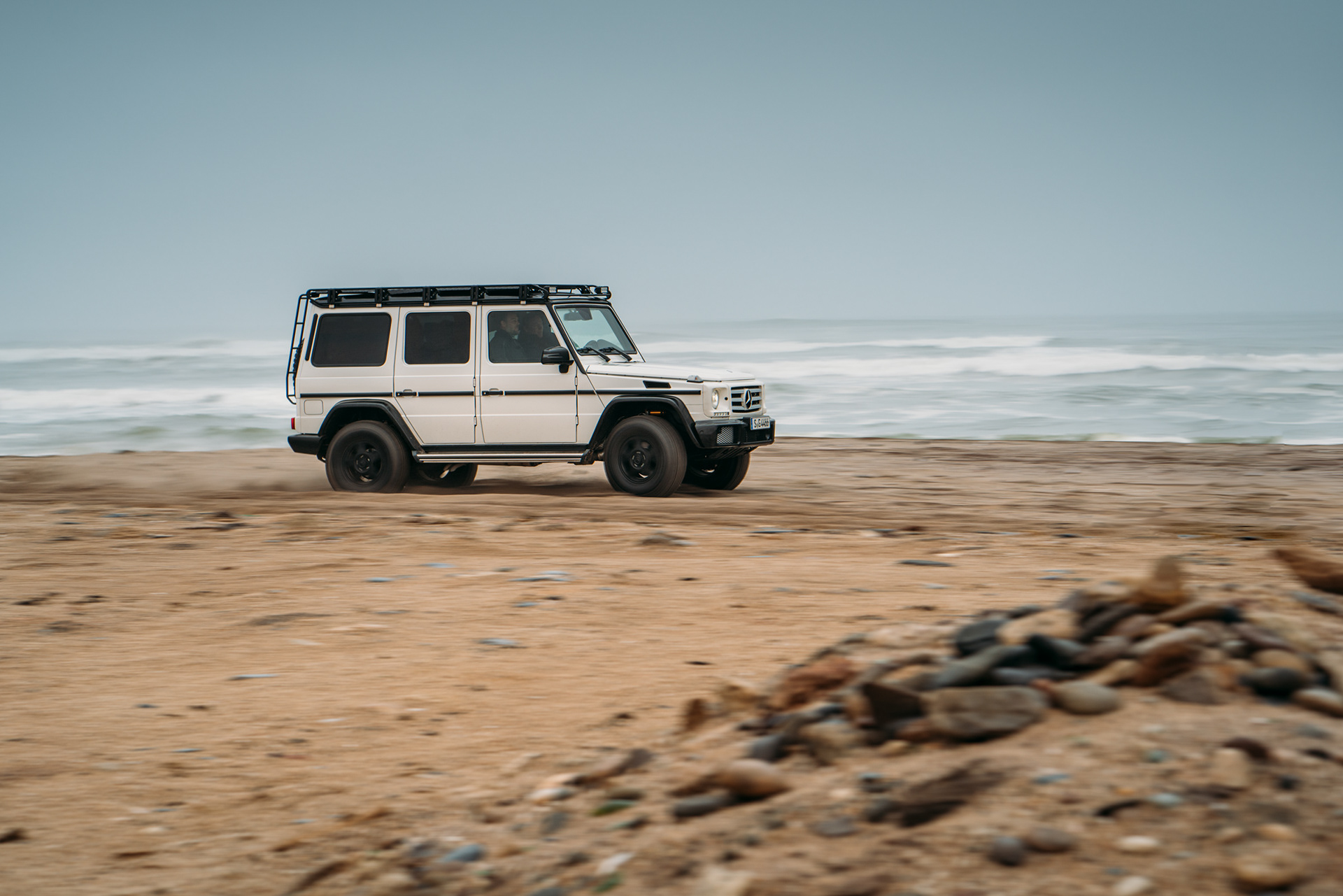

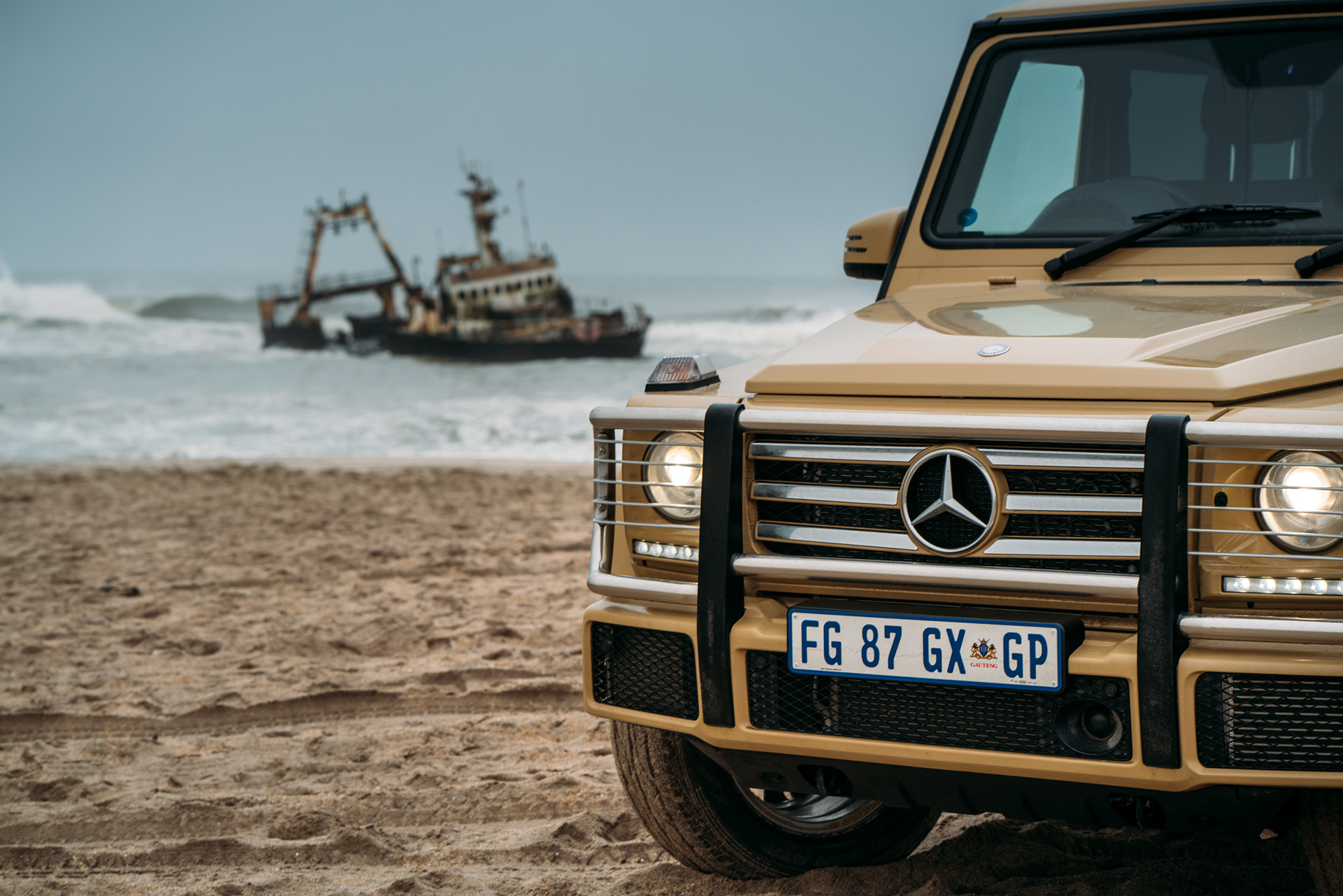
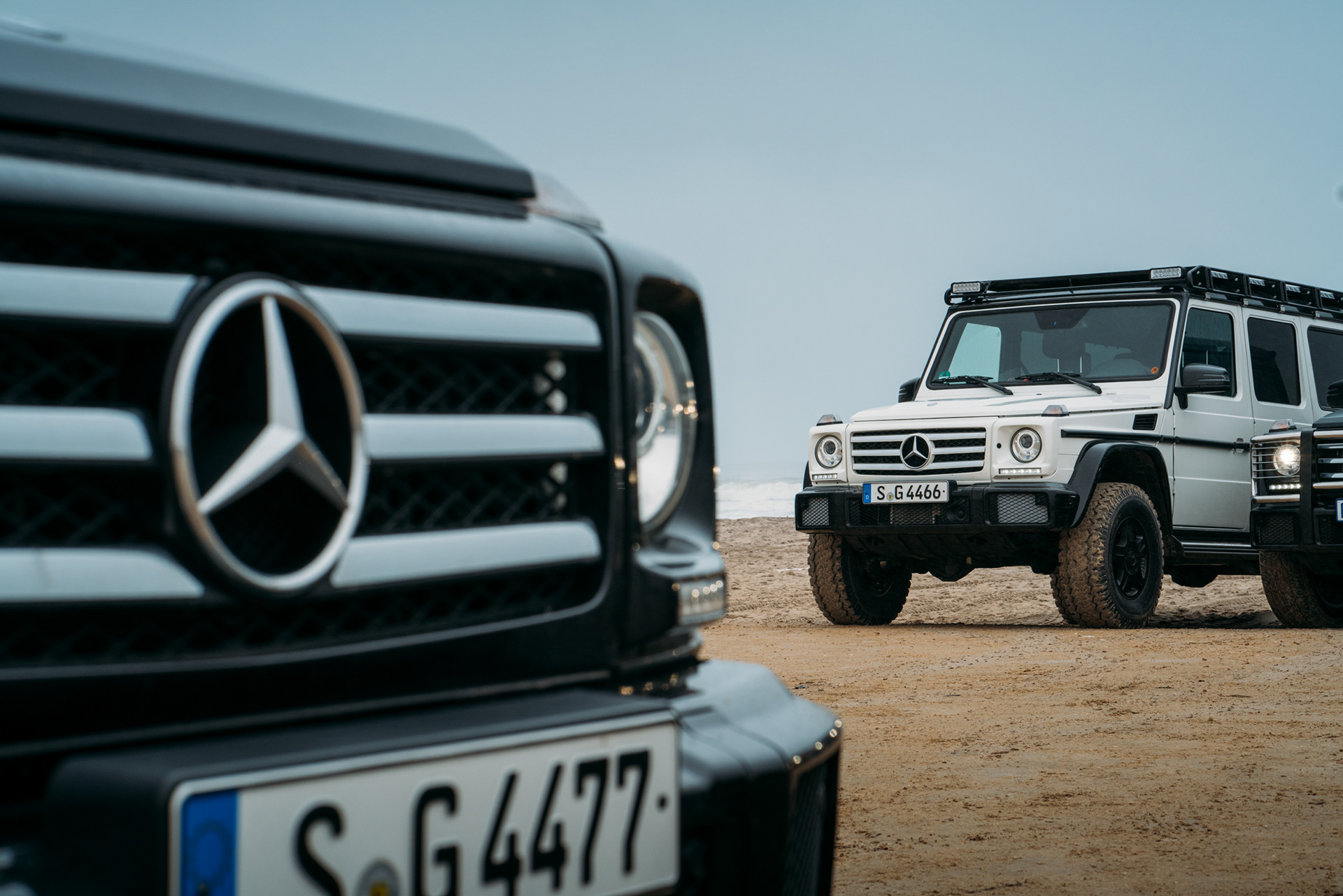


The next morning we left Swakopmund under full power: 50,000 lbs of German metal soldiering out into thick coastal fog, an ethereal border between us and the start of our adventure. There would be much adventure in the days ahead, and the first bits presented themselves just an hour or two down the road. If you can call a beach a road, that is...
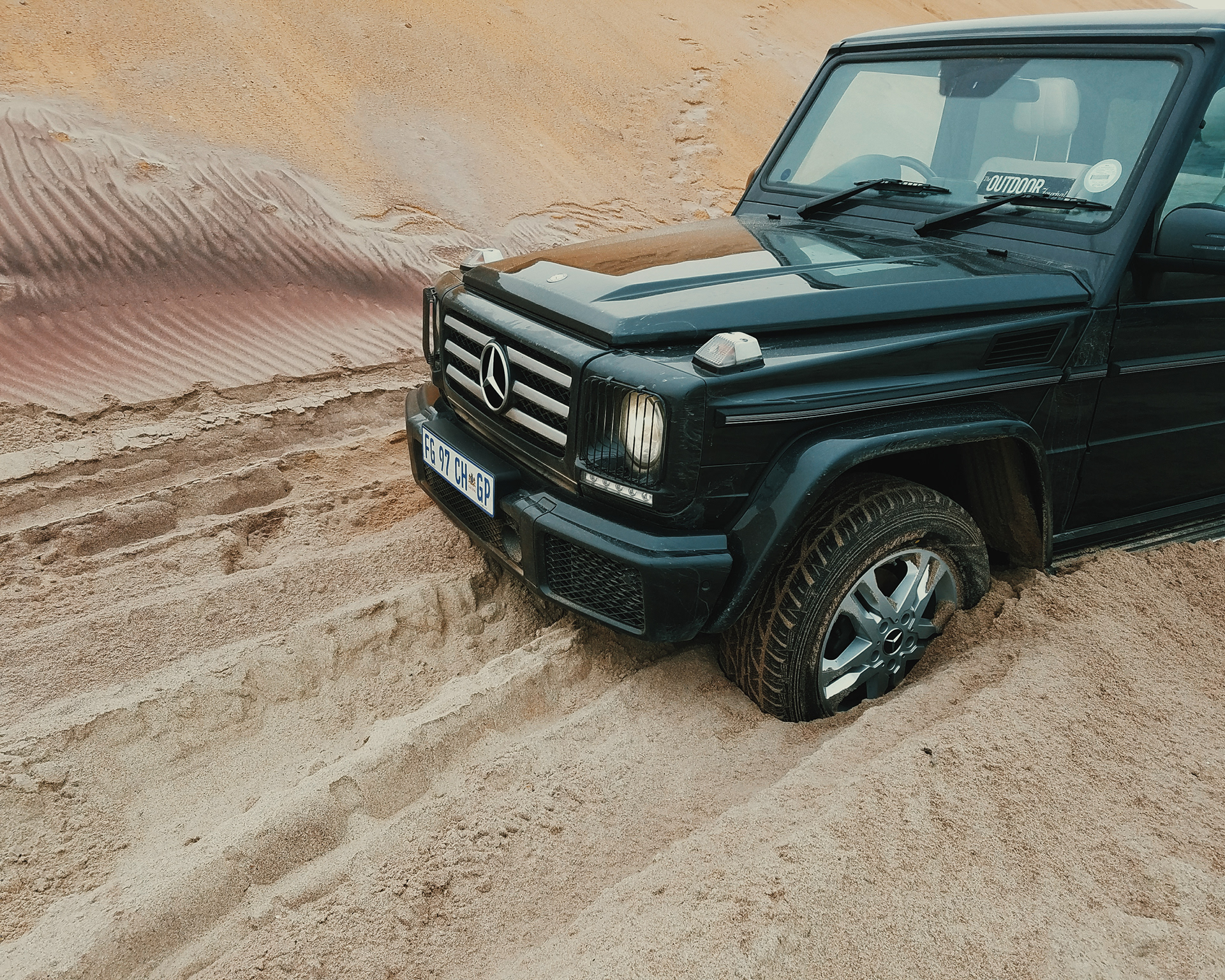
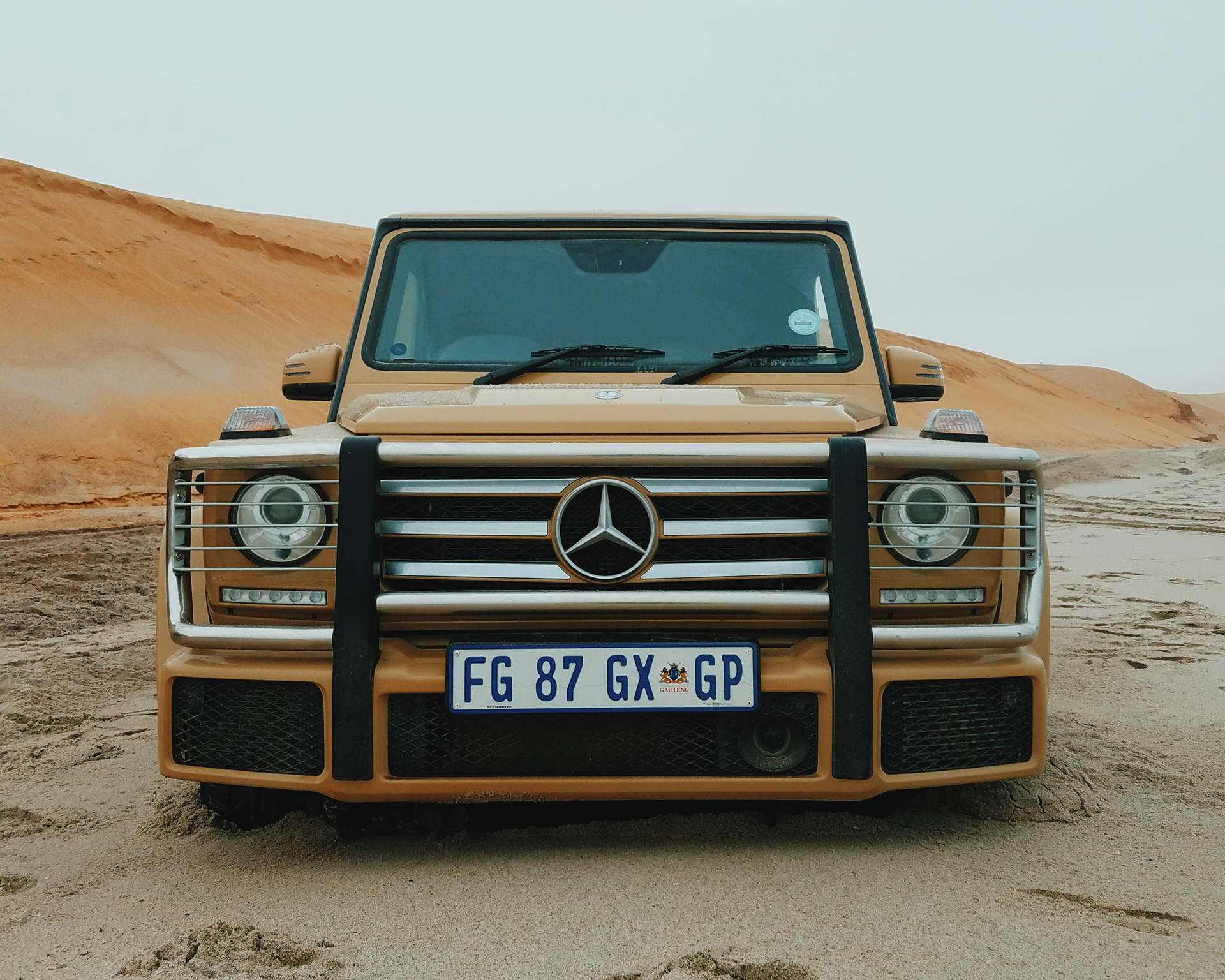
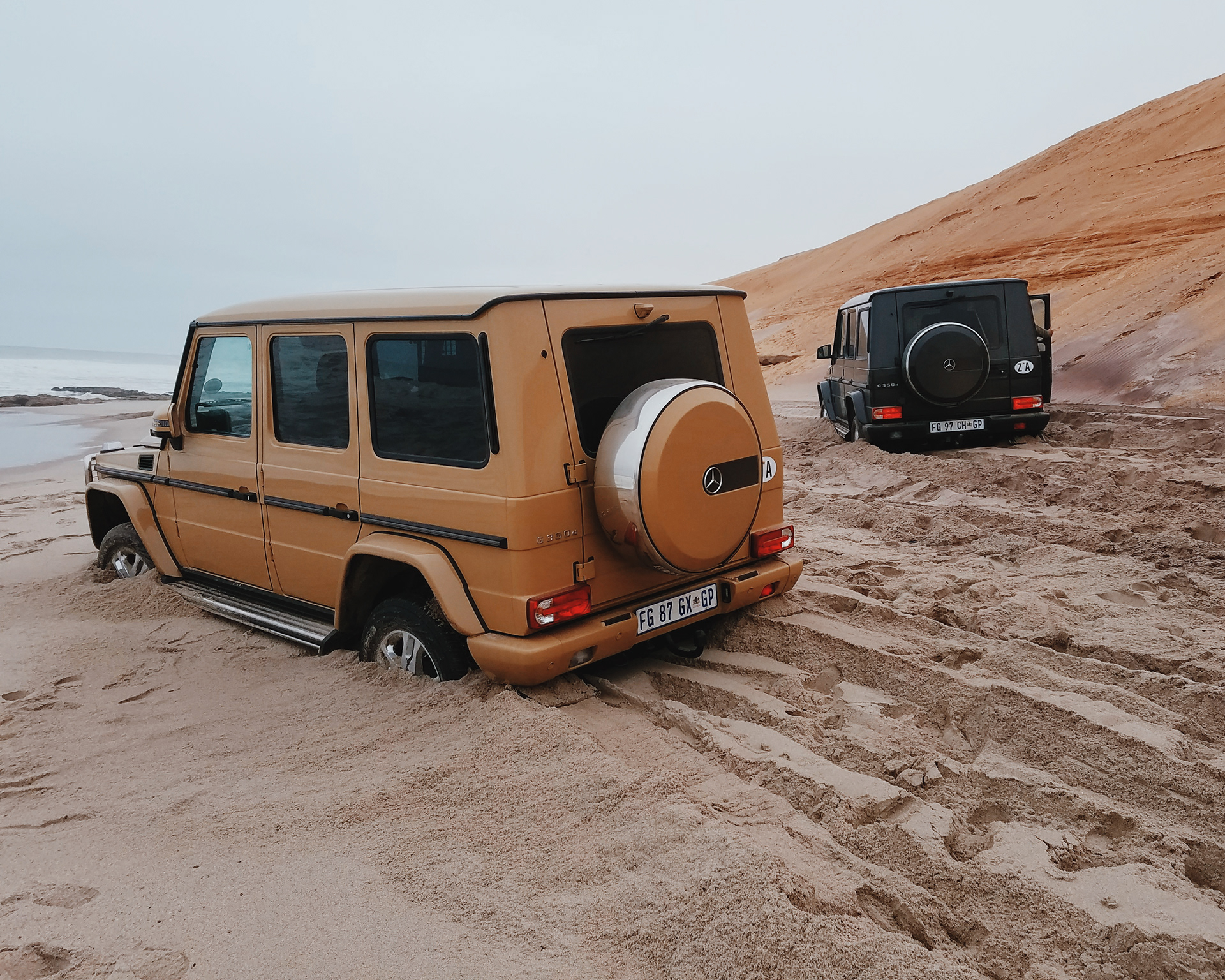
A few minutes after hitting the beach we were completely sunk in. Less than five yards away the Atlantic crashed mercilessly into sand as the tide pressed closer. Some took longer to figure it out than others, but within a few minutes we were all furiously digging sand out from under our cars, searching for tow ropes, and letting as much air as possible out of the tires. Mike and his team used the advantage of their modified G500s to help the rest of us out.
The tide is a strange motivator. Seeing journalists from all over the world work together against the clock in Mike's bid at forced gonzo journalism was both entertaining and inspiring, and Mike's attitude and interactions with all of us during that period were clear evidence of his abilities to help other people find success.


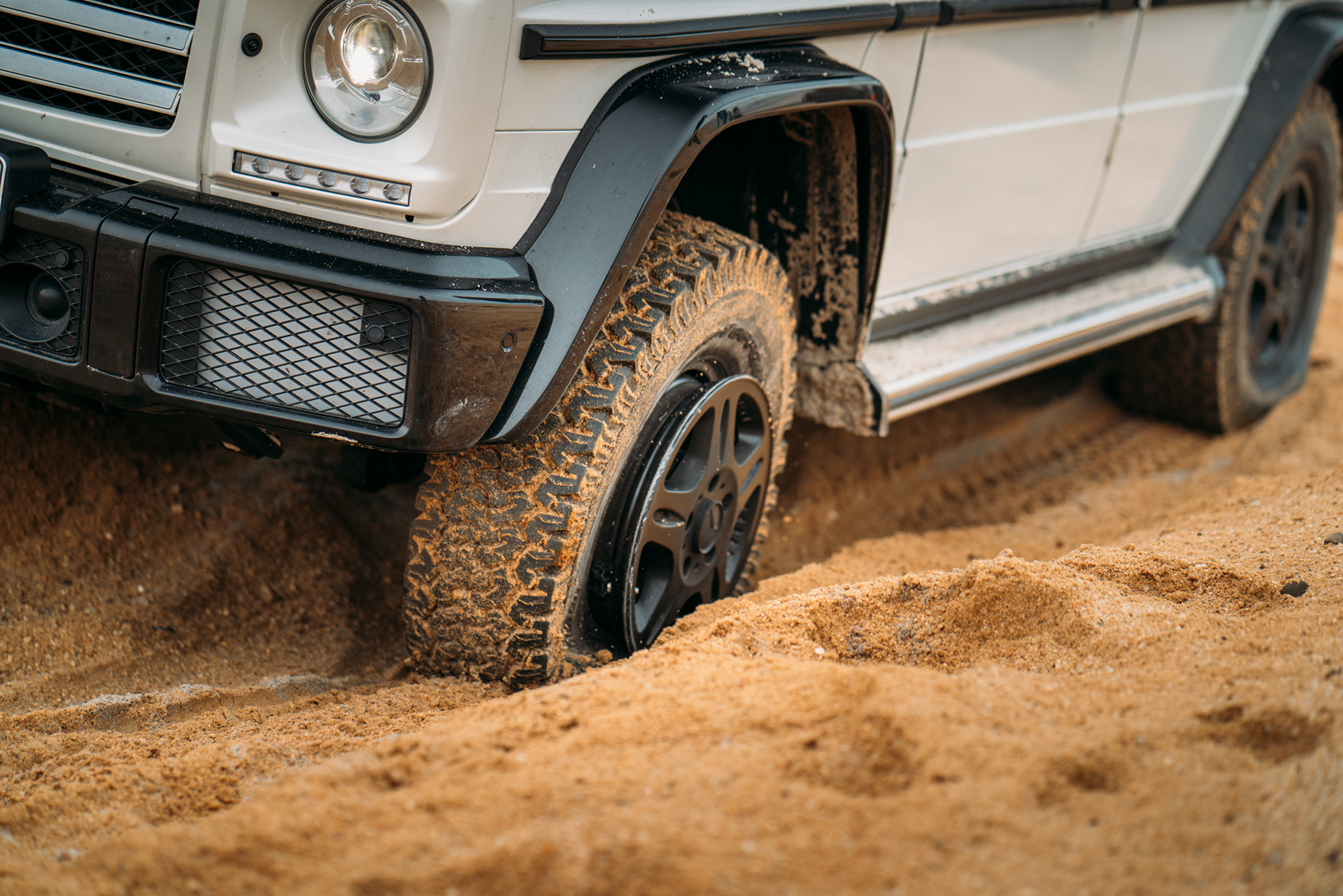


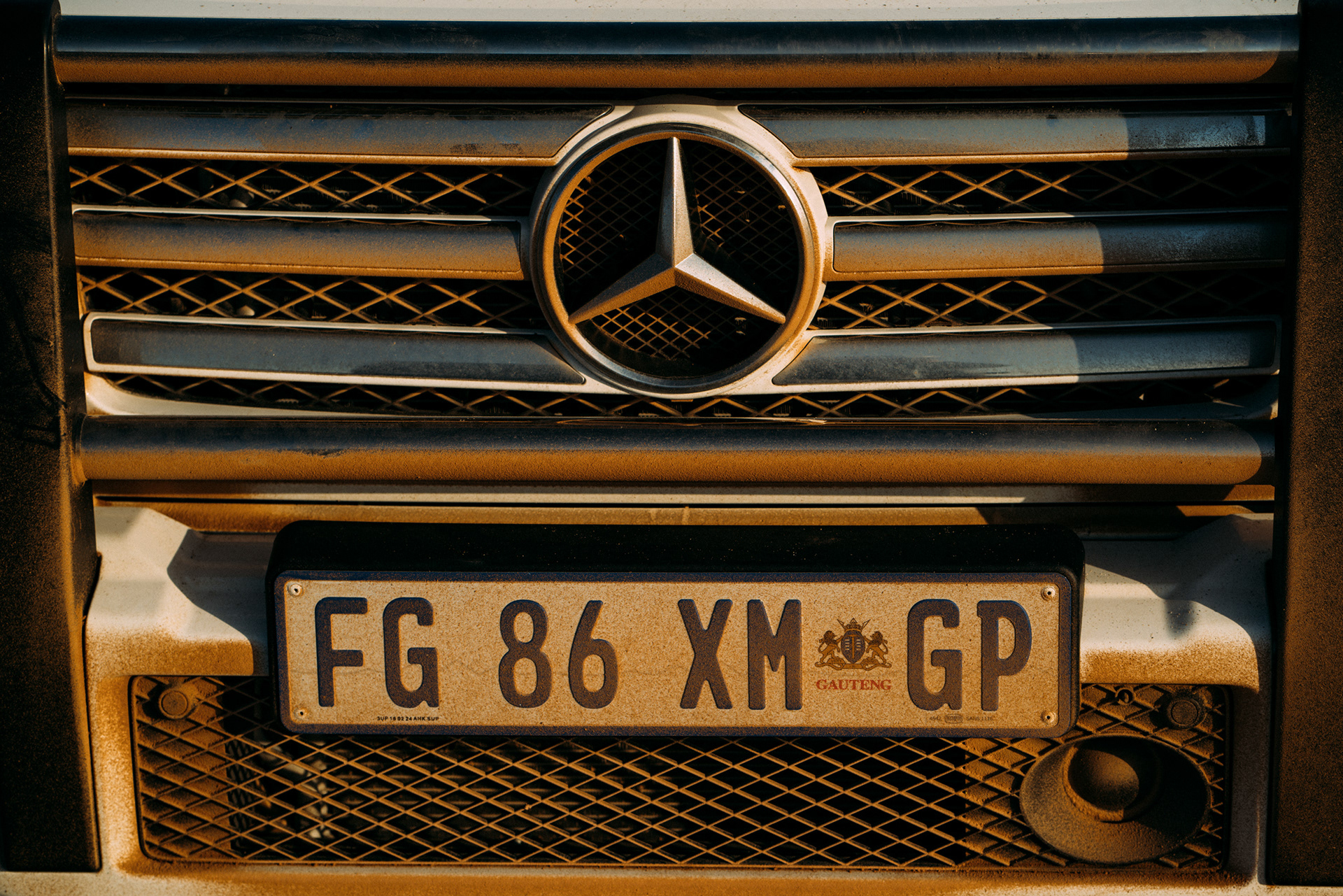

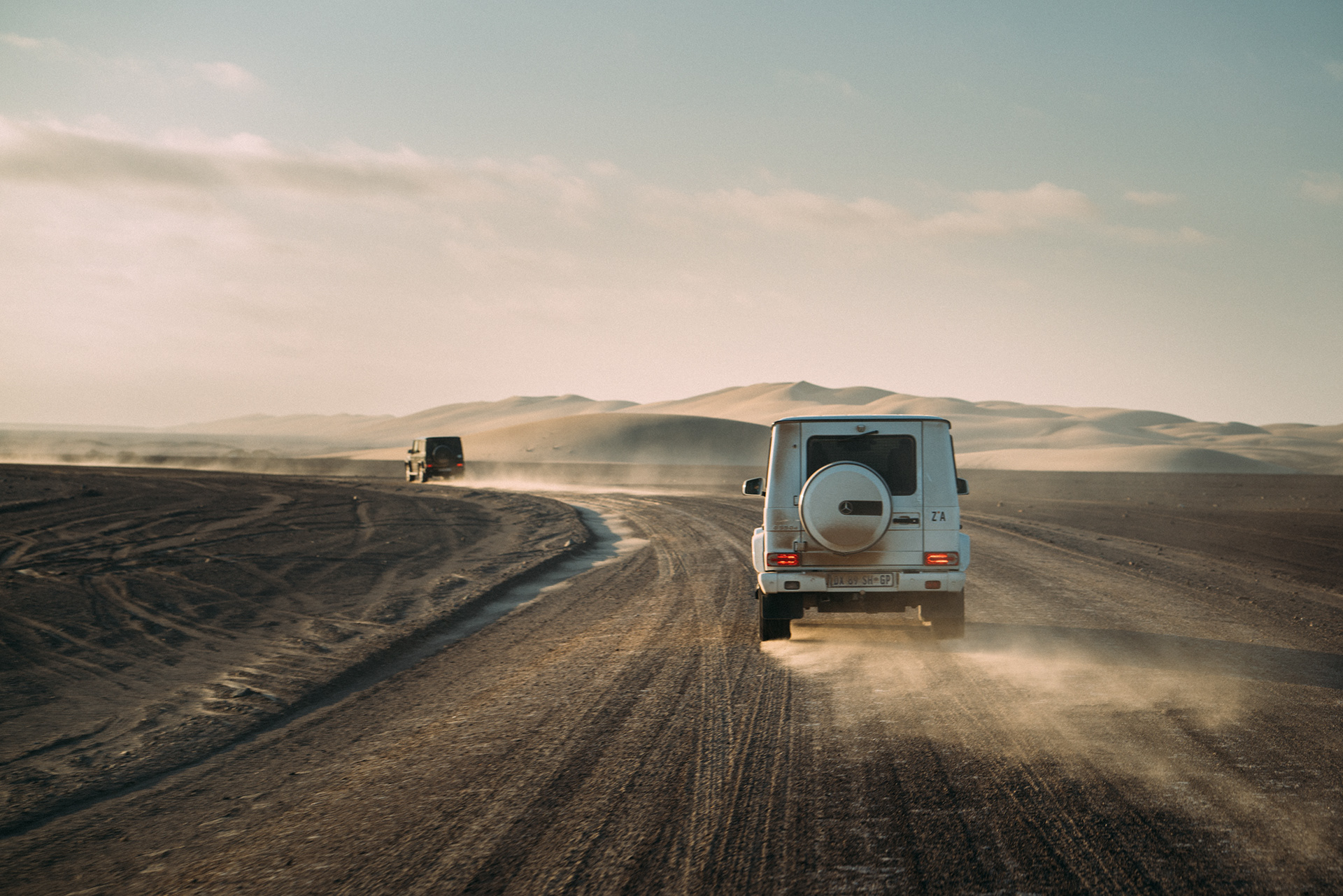
With a bit of sweat and some teamwork we all made it out in short form, aired up, and were back underway. So it went for the rest of the trip: it Mike's fully prepped G500's wearing gas dampers and offroad tires versus Daimler's fleet of stock G350 Diesels. Little did we know this separation would play a major role in the mechanics of our adventure to come.
To be fair, Dunlop makes a perfectly good OEM tire. Had we used them as they were intended I have no doubts they'd be fantastic. Reframed in the context of Namibia's mutant landscape they are considerably less able, and their fragility was revealed later that day when my left rear tire unceremoniously exploded north of 120km/h while chasing Mike down one of the dustiest roads I've ever been on.
She handled it surprisingly well, barely registering any drama despite the relatively short wheelbase and high speed. We got back underway as sunset approached. I traded the driver's seat for the camera and the first of several incredible desert sunsets. By the time we finally made camp we'd been on the road for roughly 14 hours, the last two of which were simply finding the nearest fuel. I stumbled around for a few minutes, then took a long gaze upward at what was one of the clearest night skies I'd ever seen before unceremoniously collapsing into a tent.
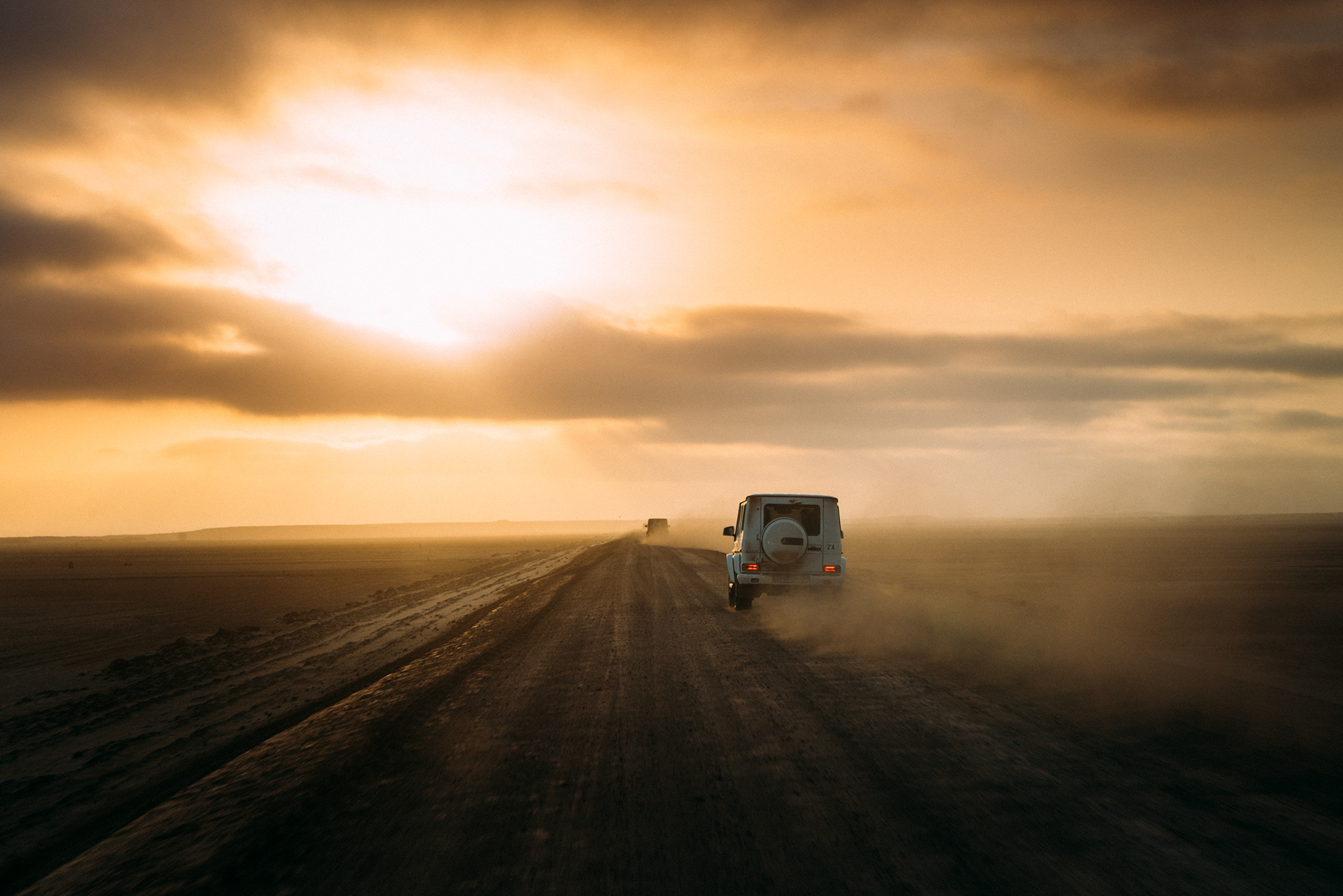

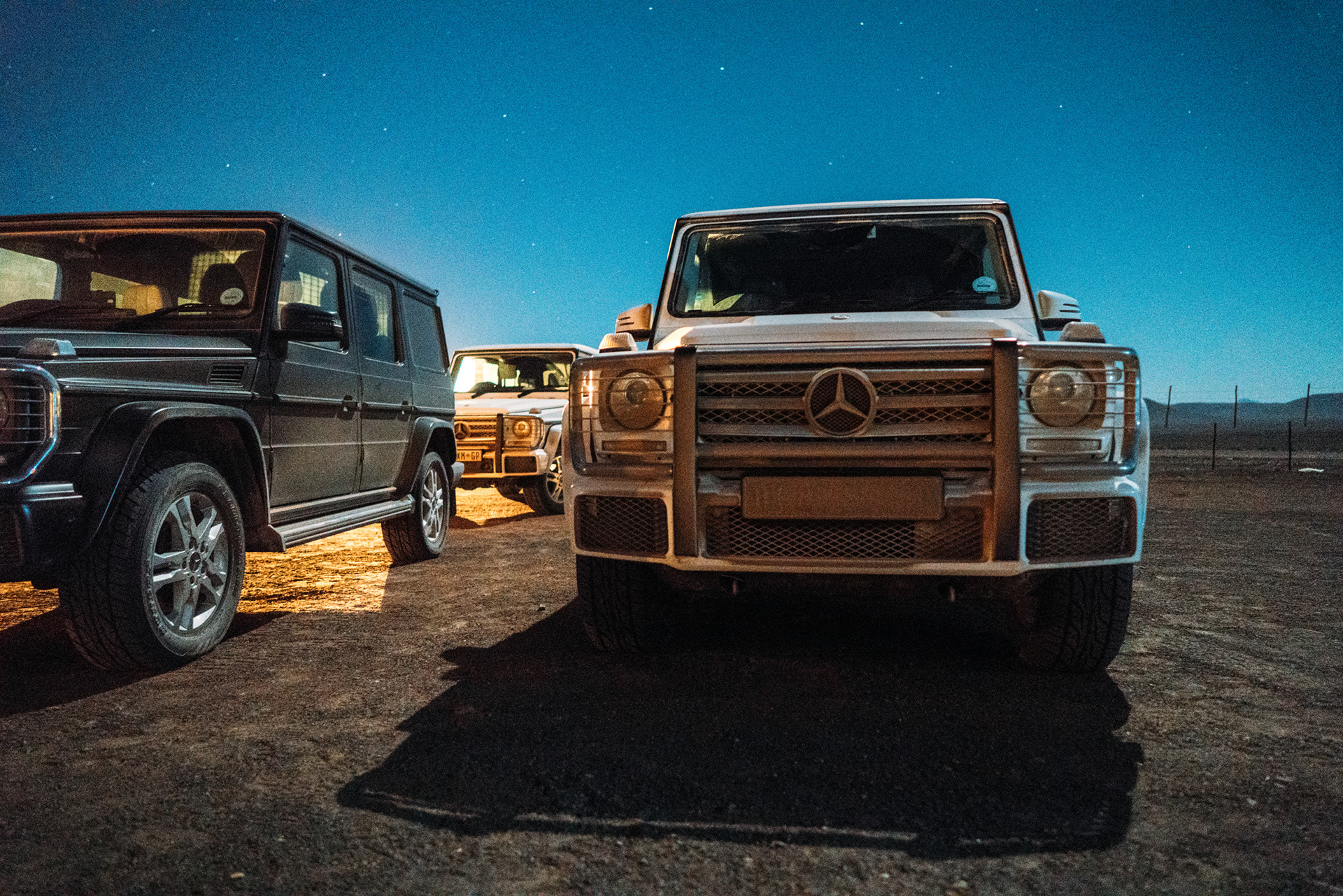
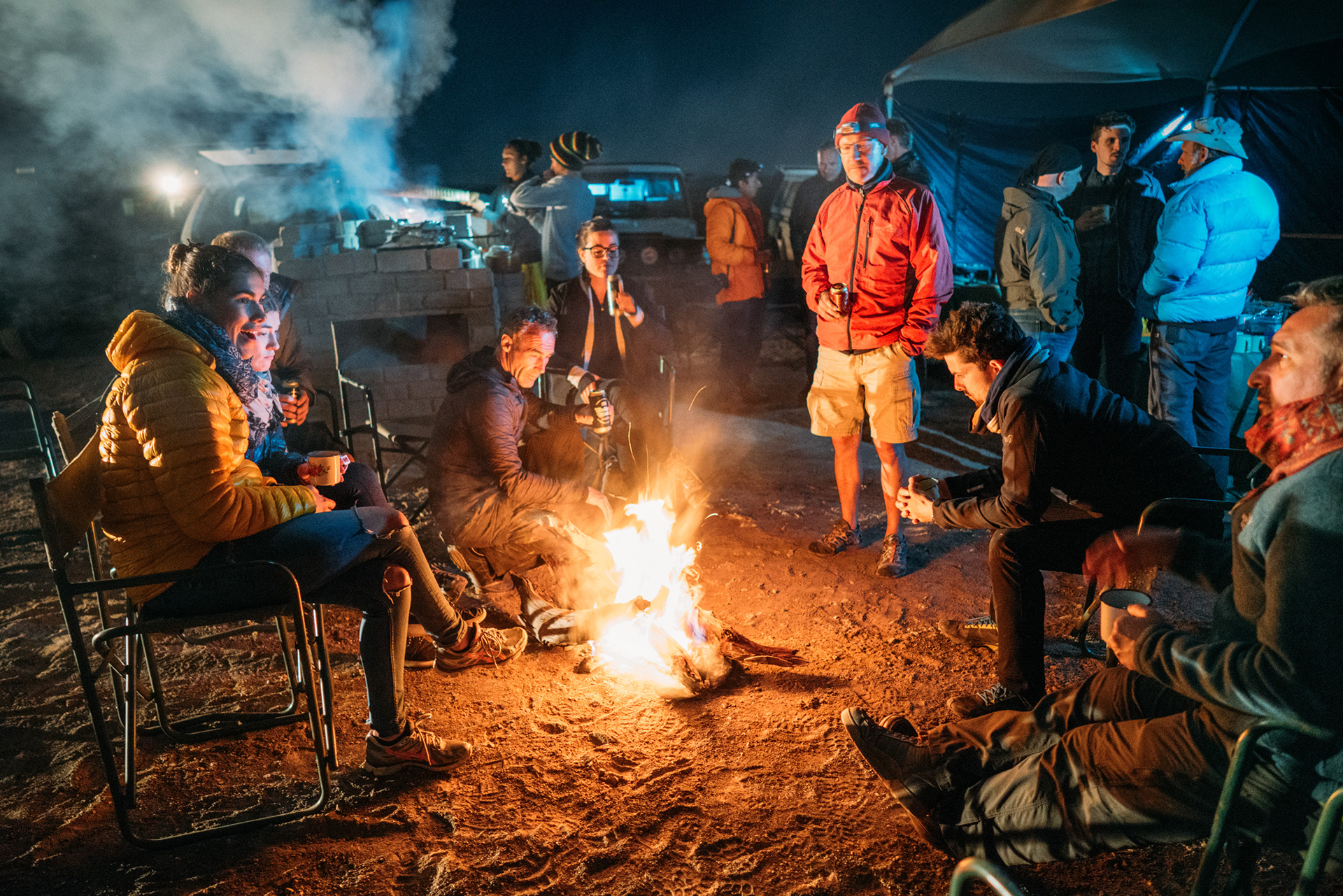
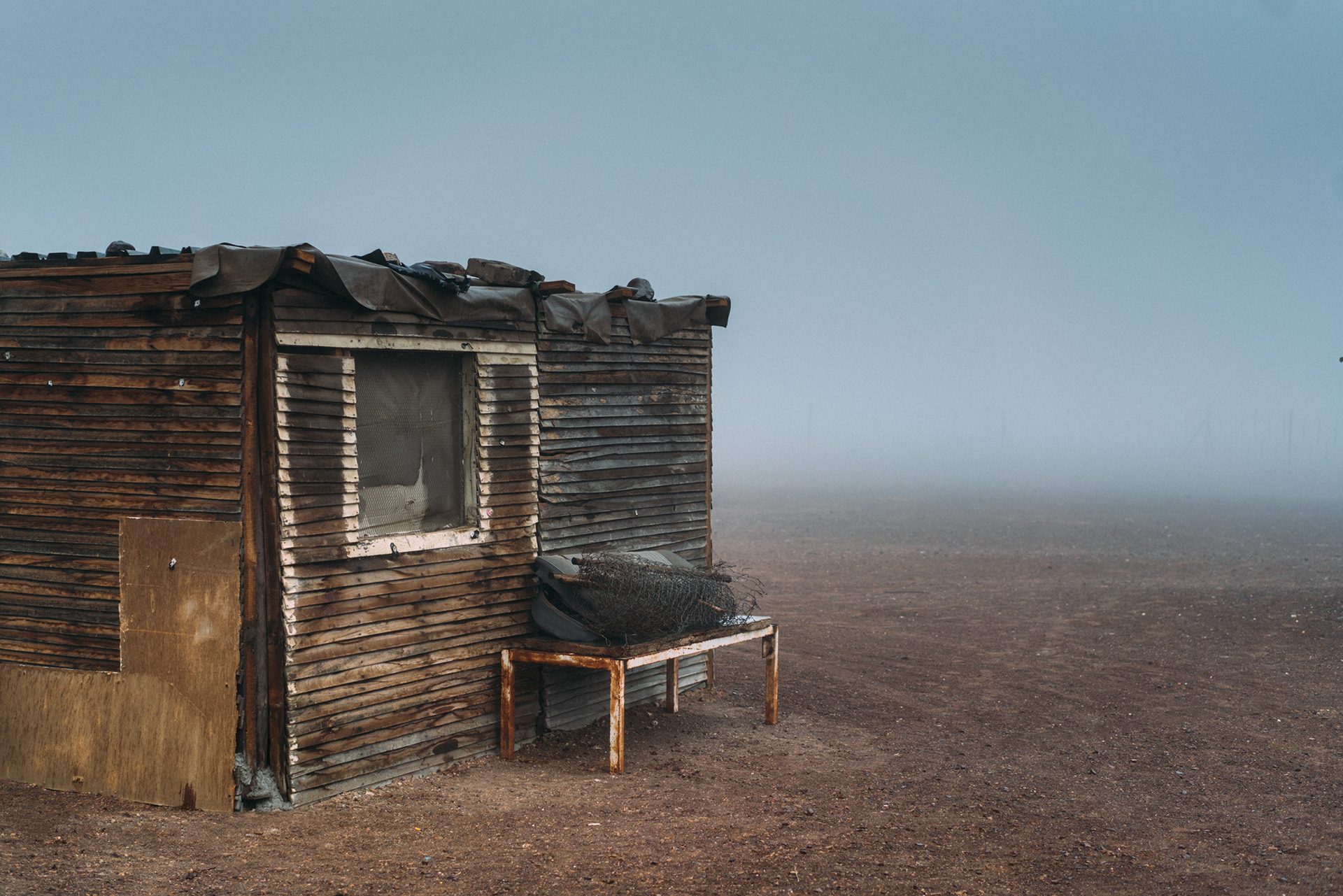
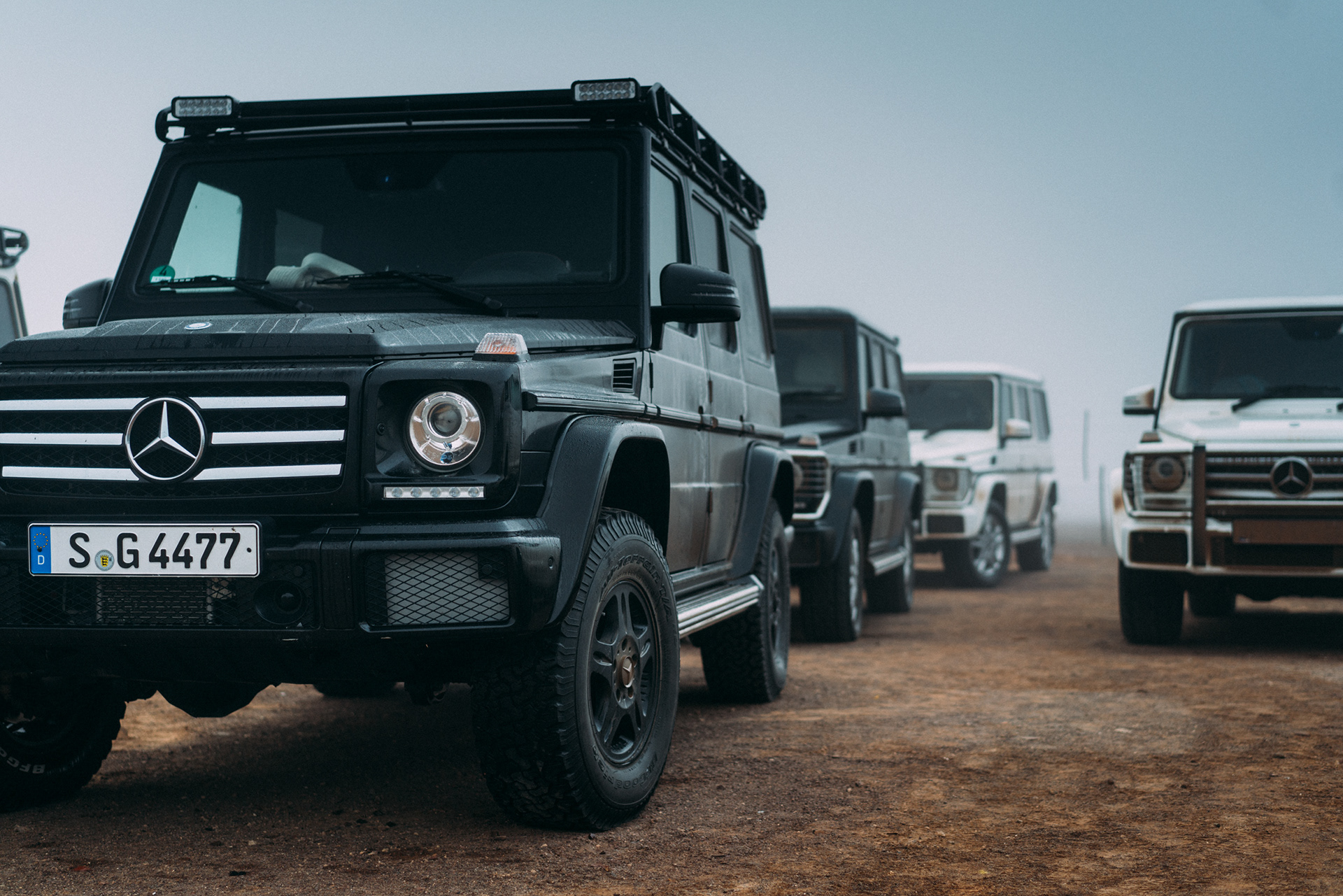
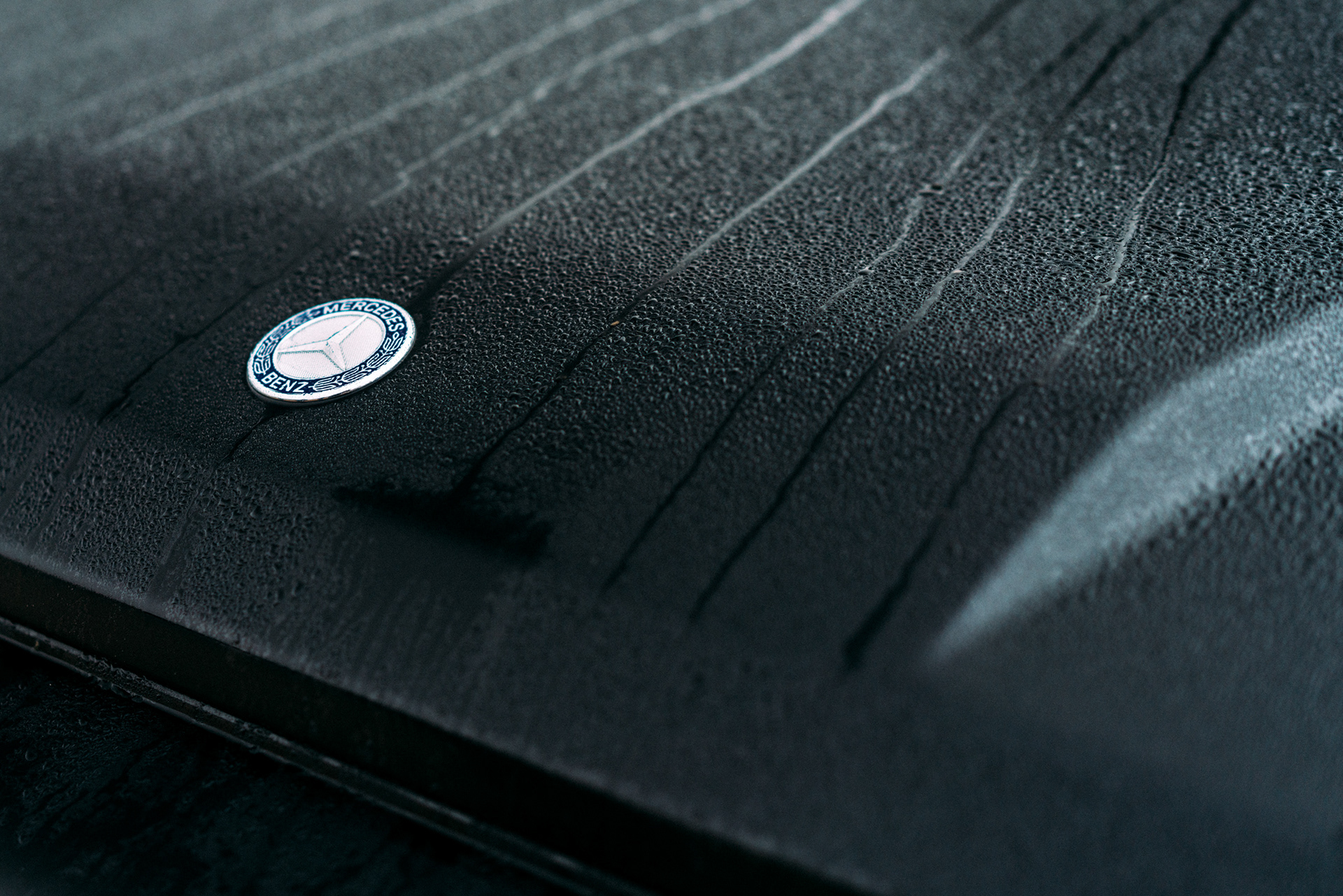

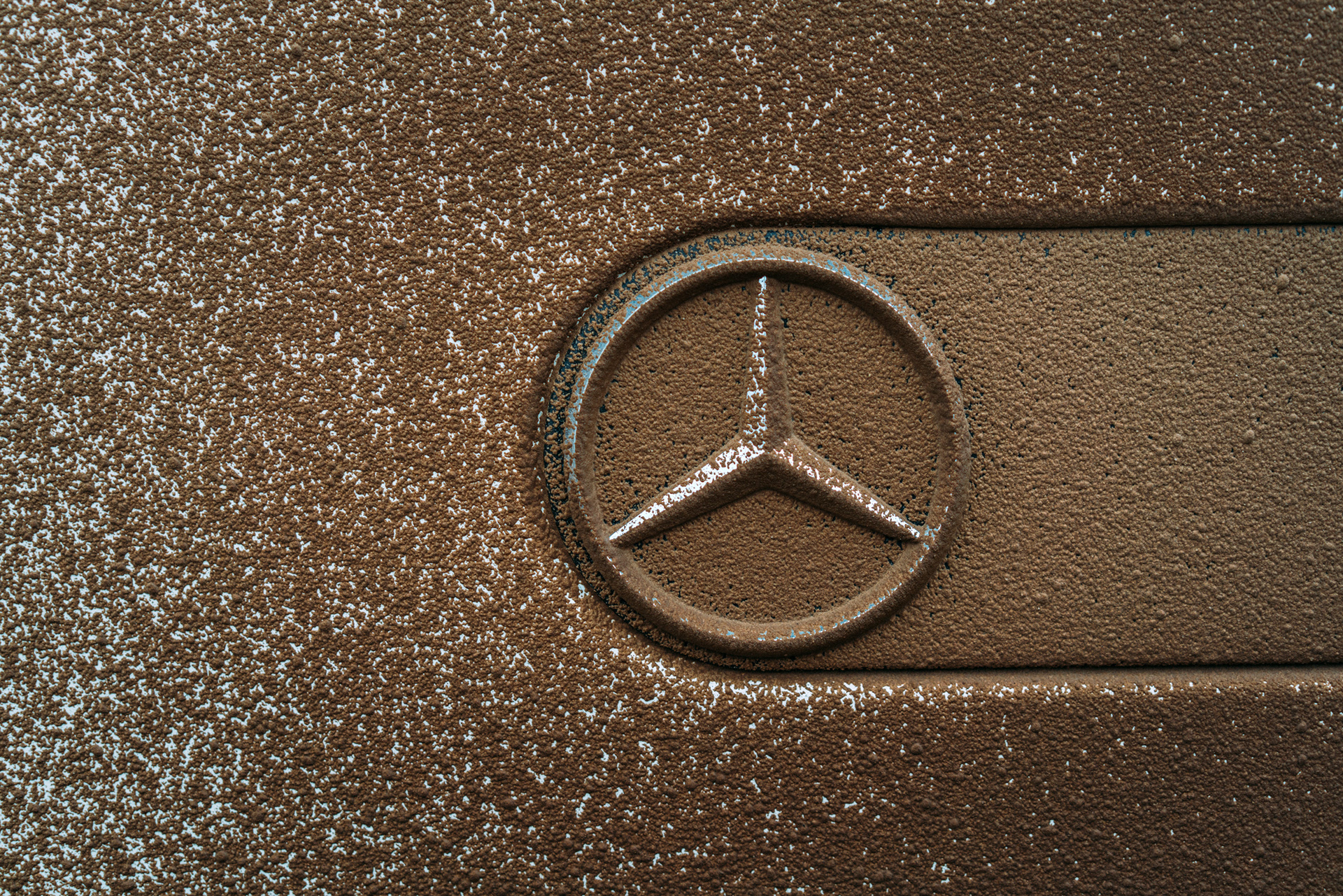
Morning delivered frosty temperatures and pervasive mist, a reminder of our proximity to the coast despite otherwise desert-like conditions. Visibility was limited but by early afternoon it had burned off and given way to terrain with incredible contrast, more alien and sinister than what we'd seen the previous day -- wide martian expanses almost flat for as far as the eye could see, suddenly replaced by riverbeds teeming with life, marked by the occasional stop for a flat tire.
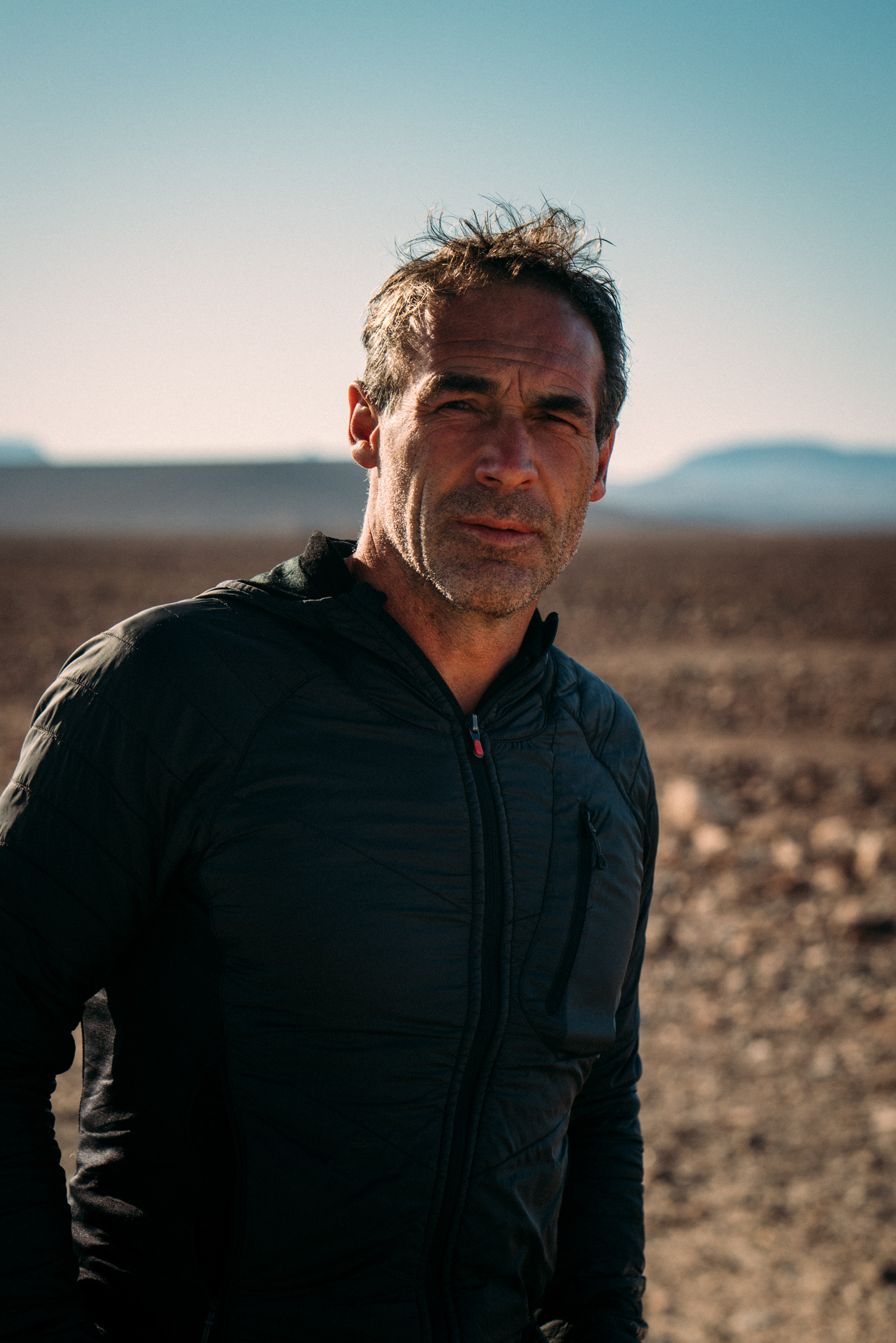
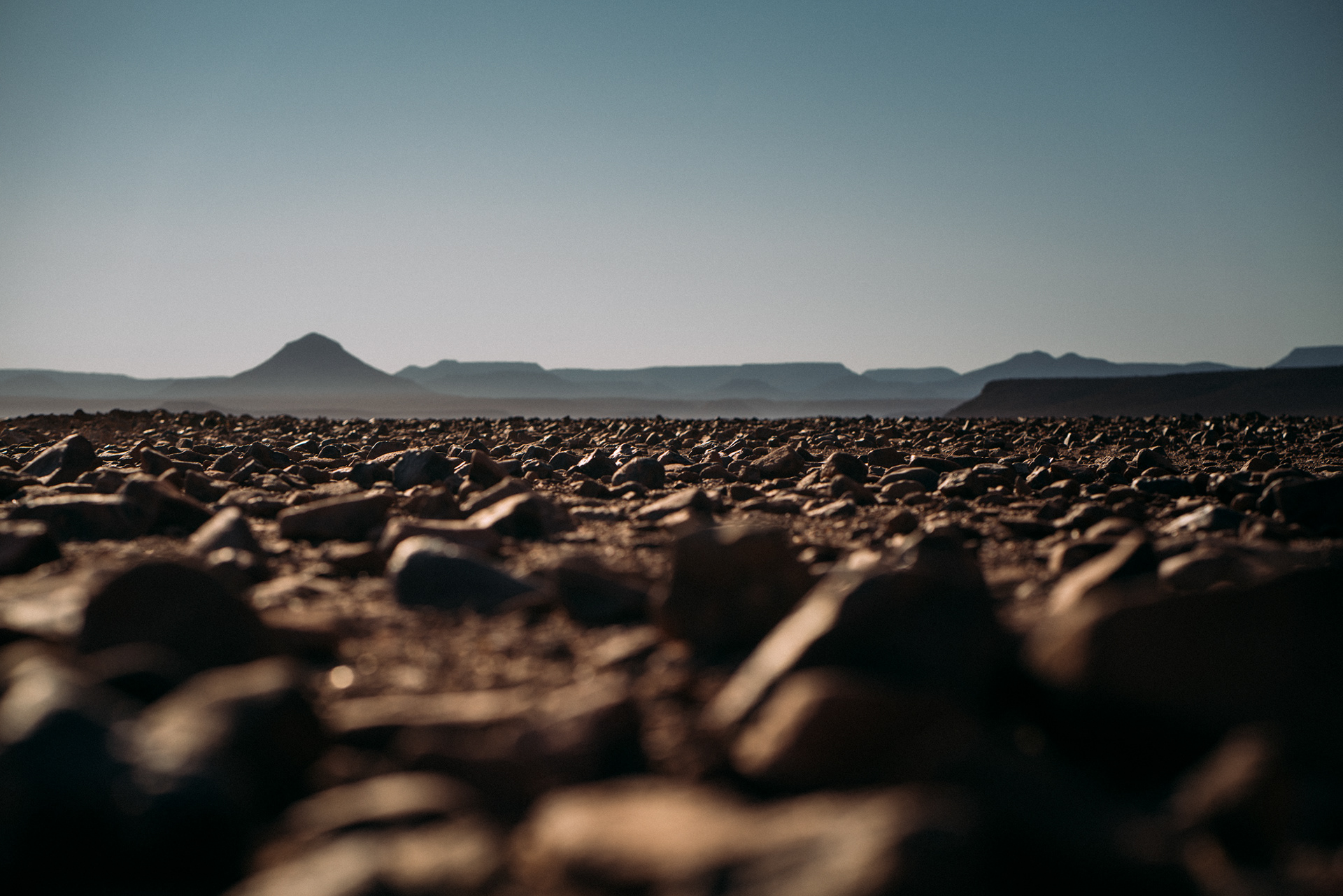
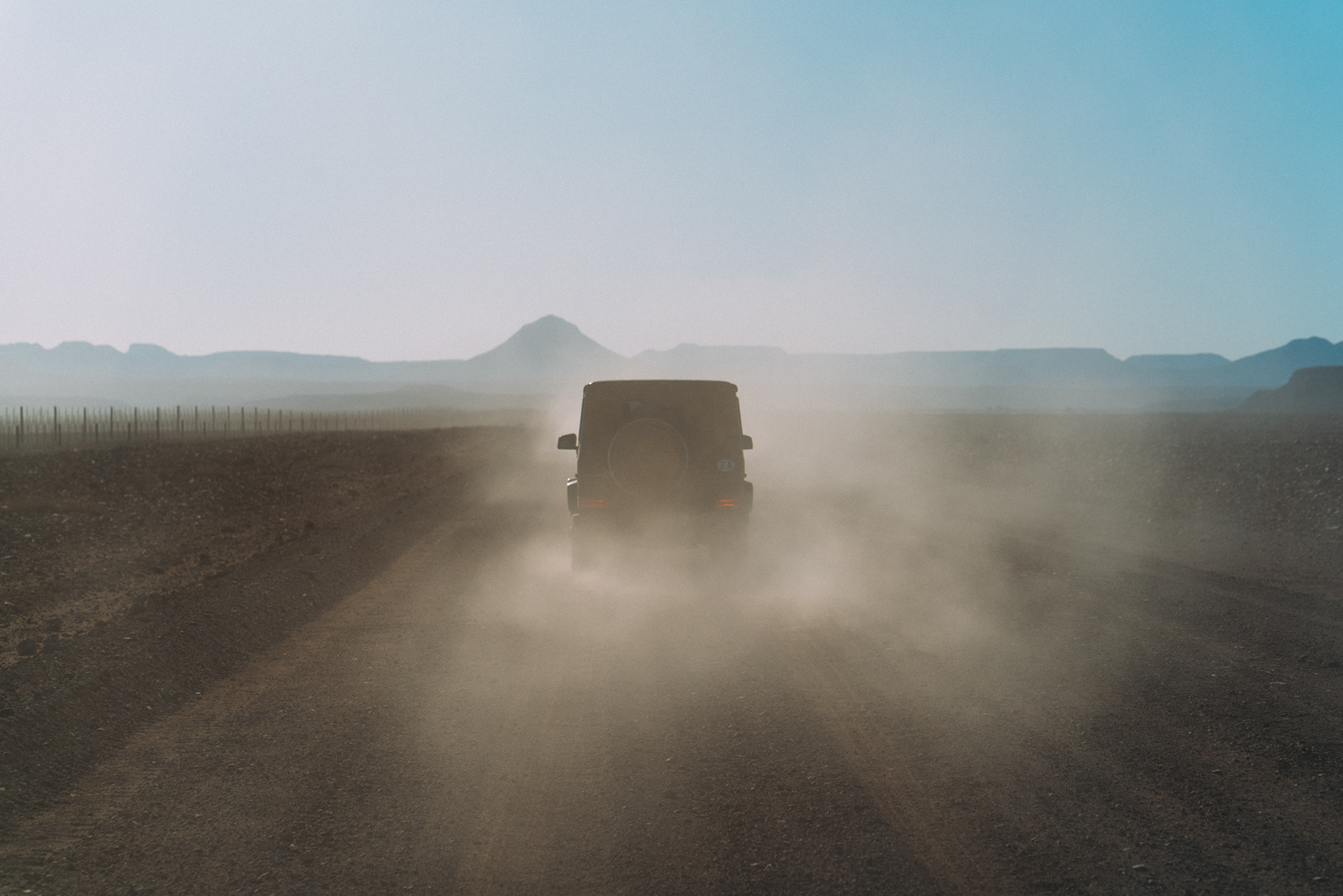

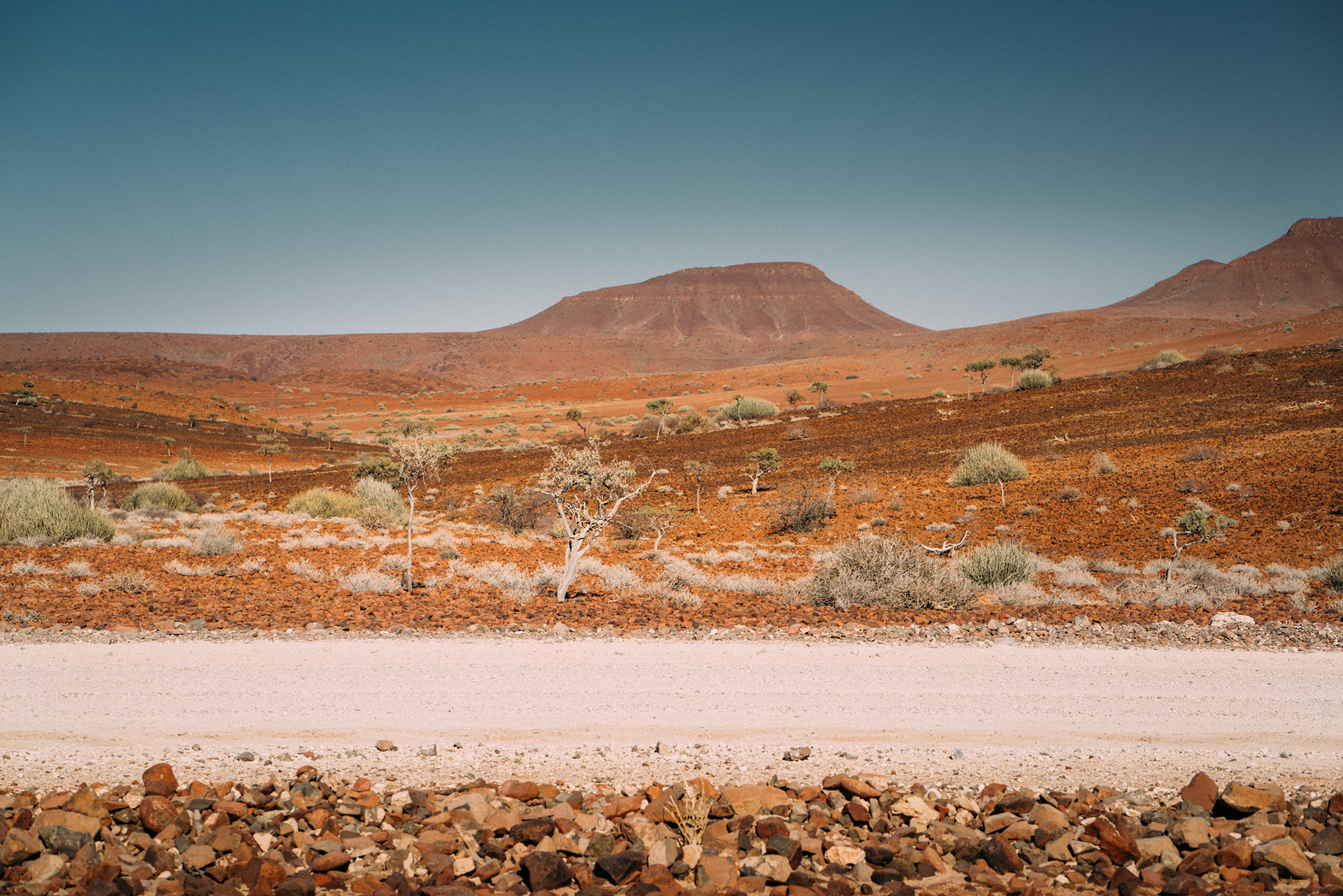
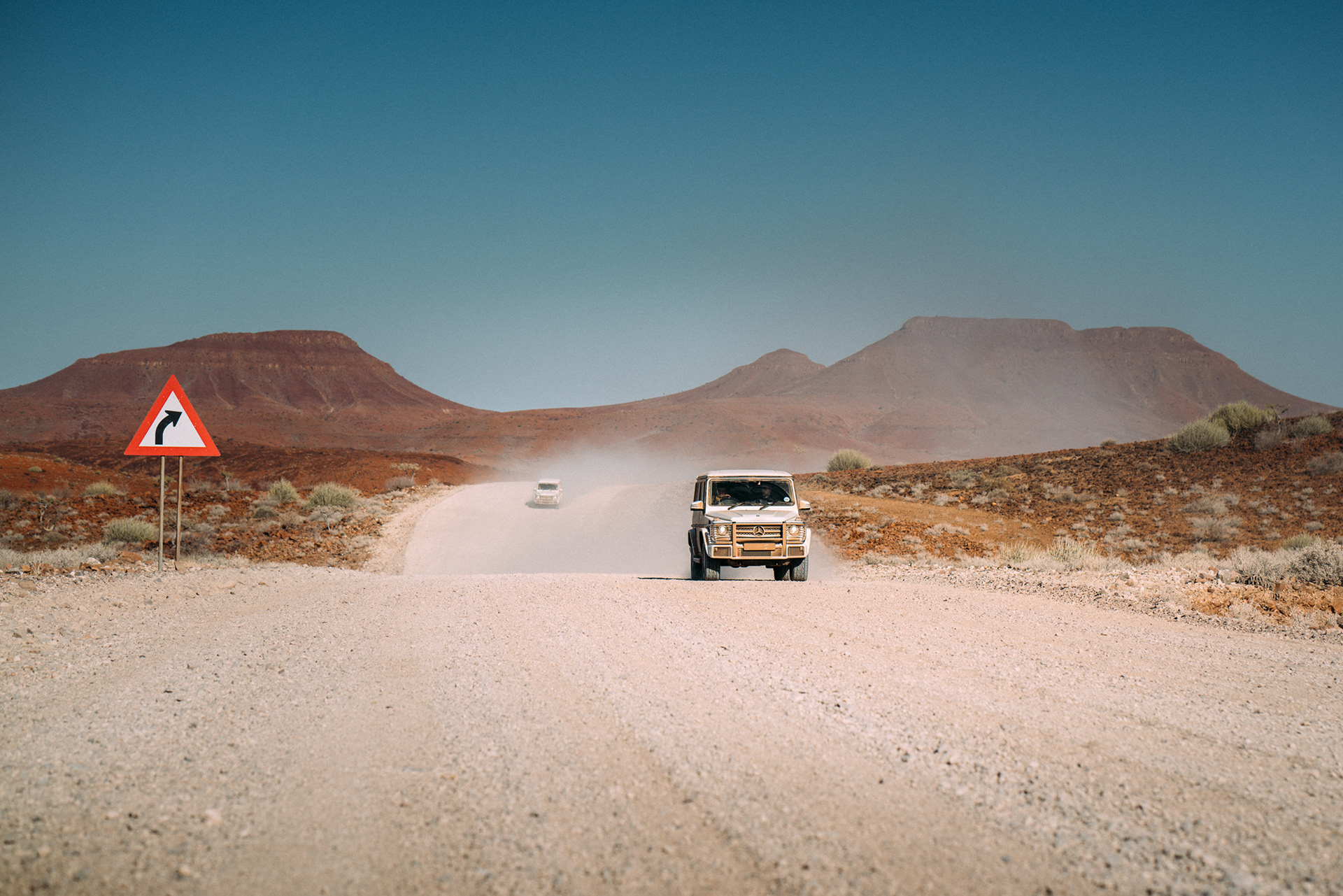
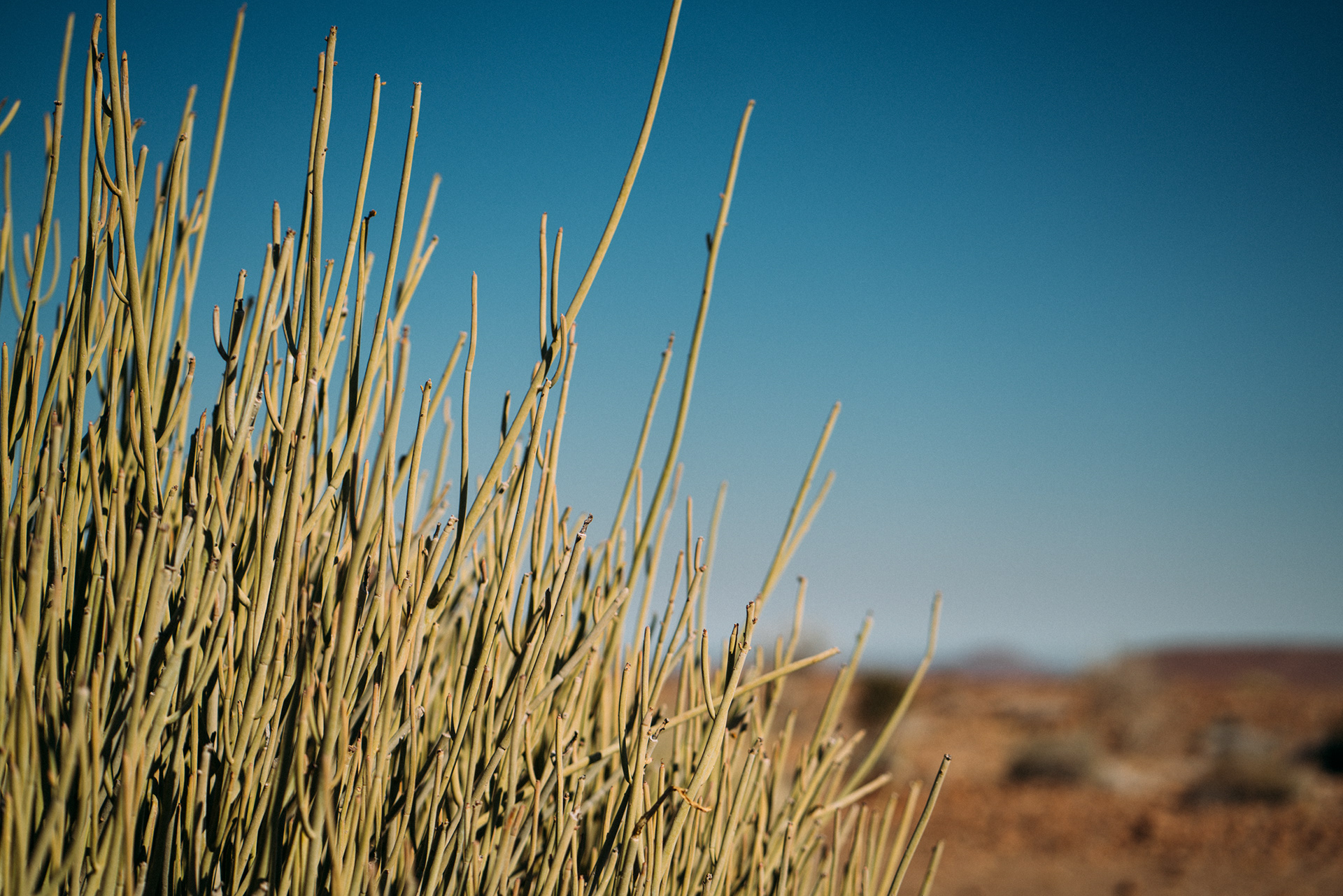
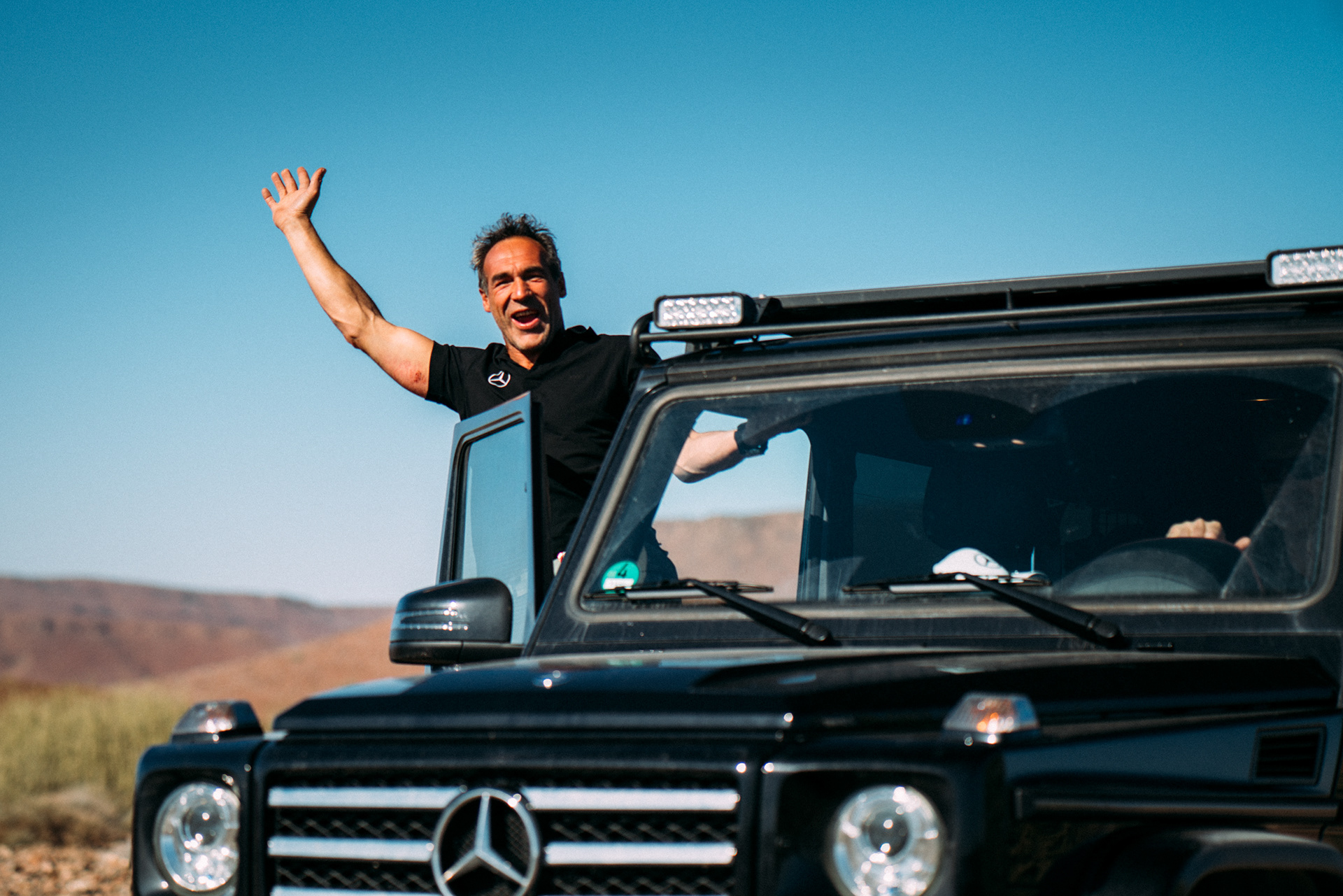
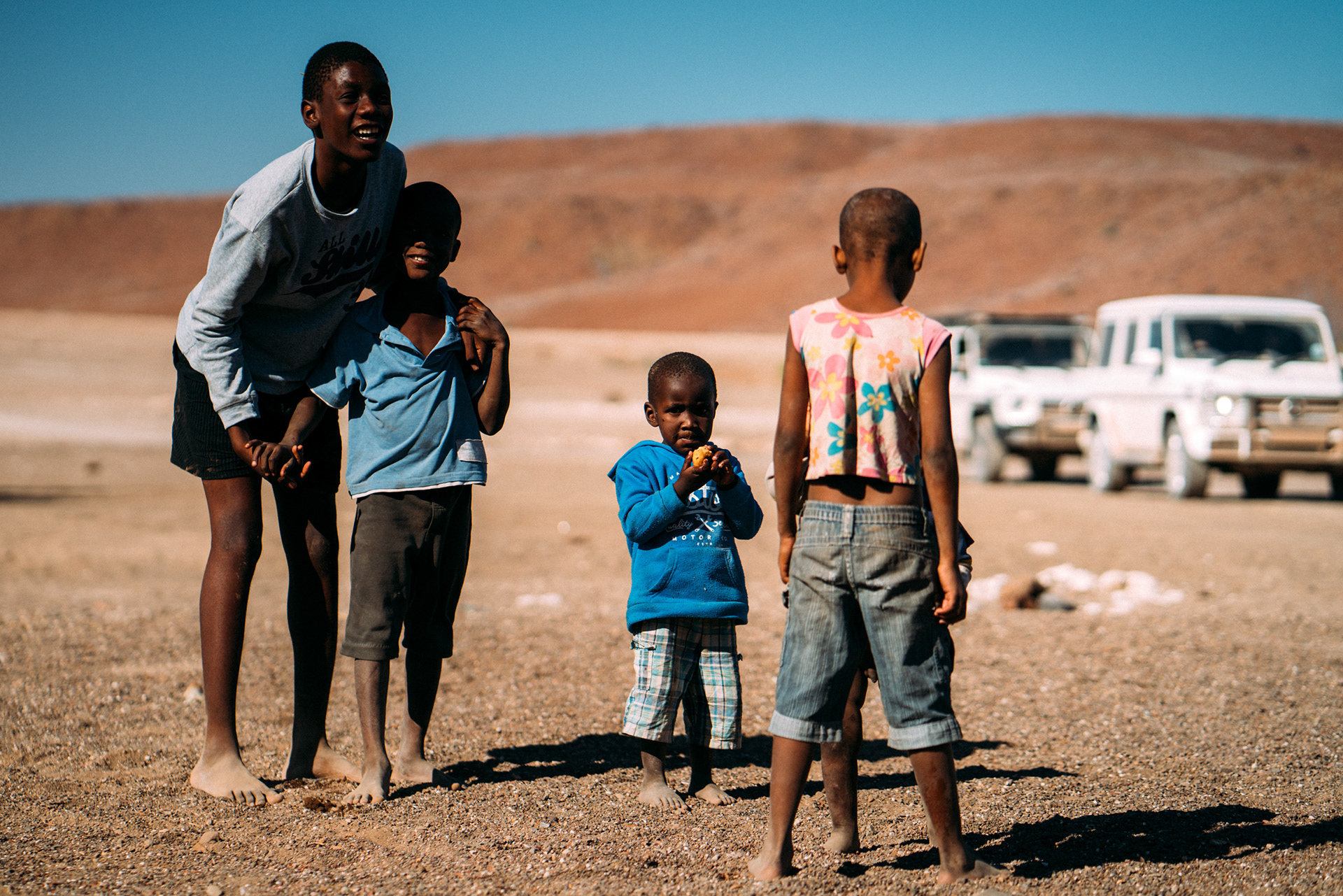

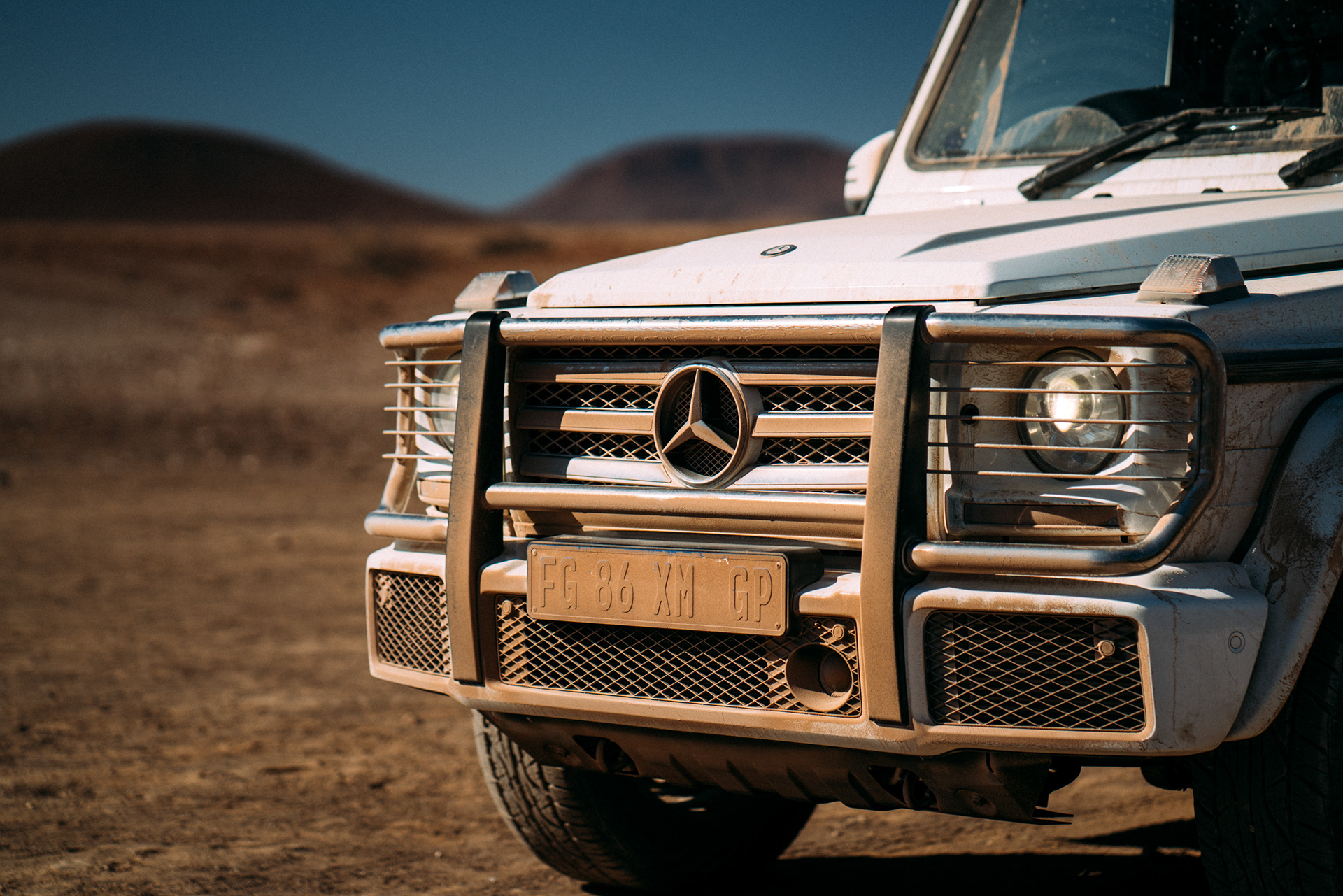
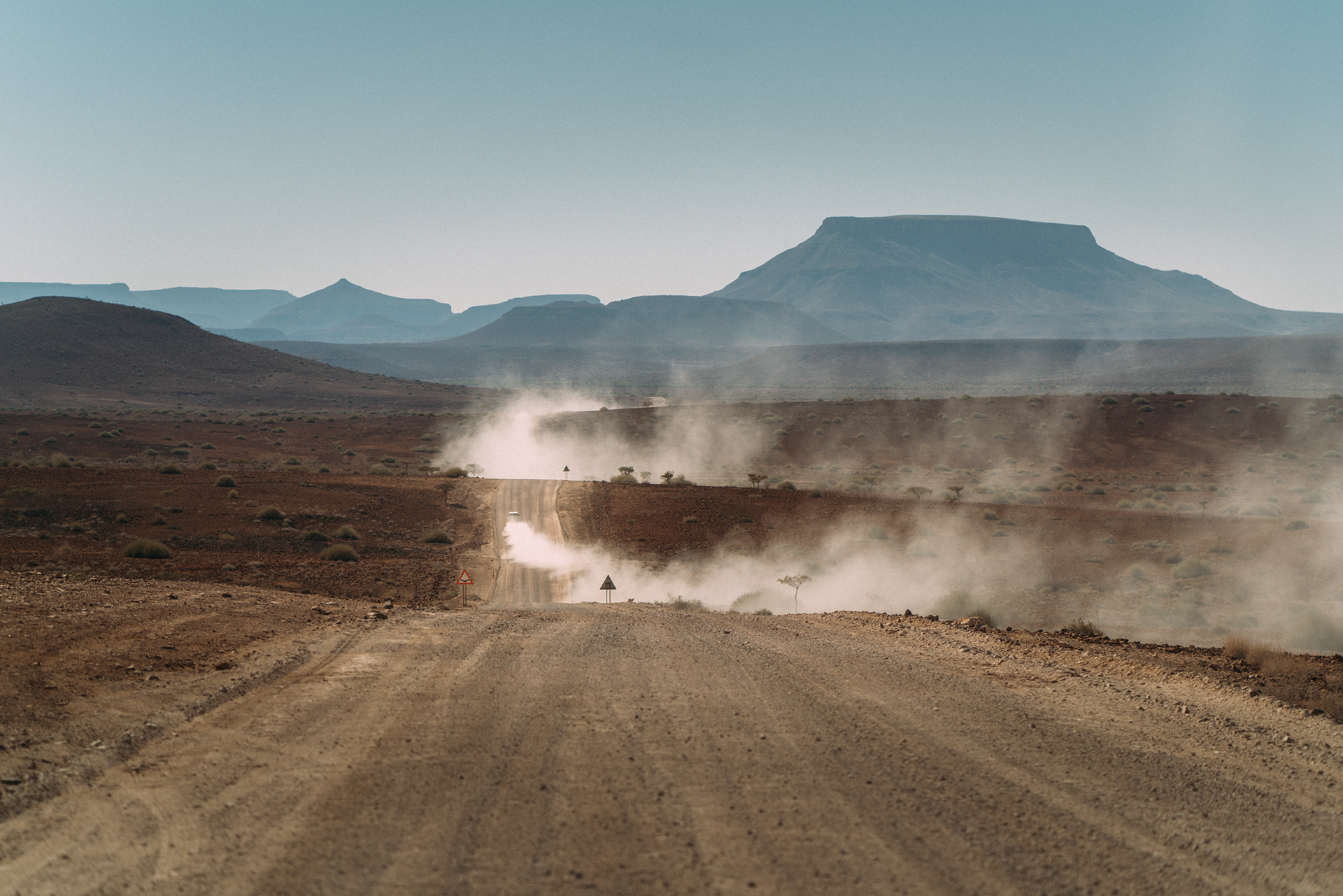
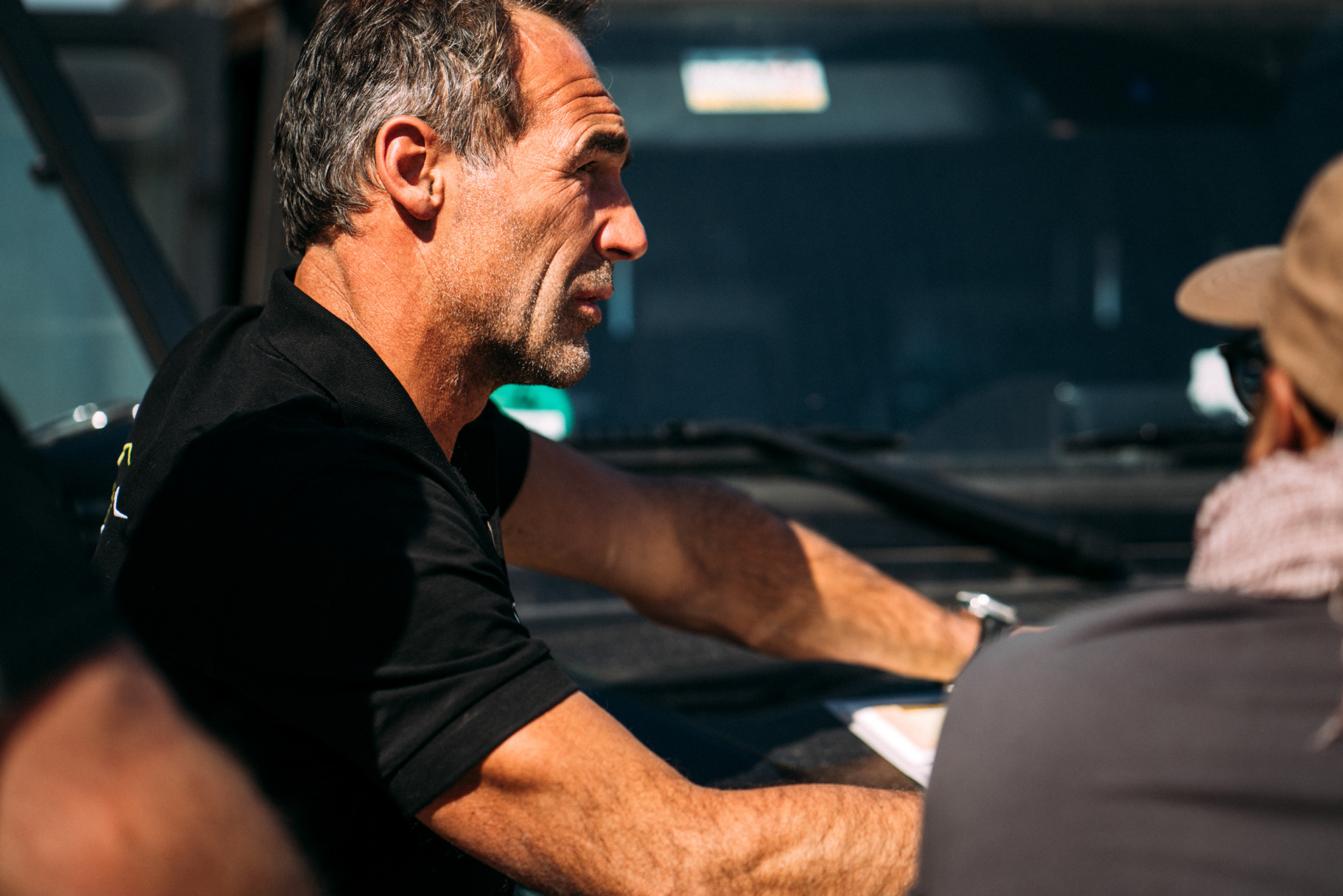

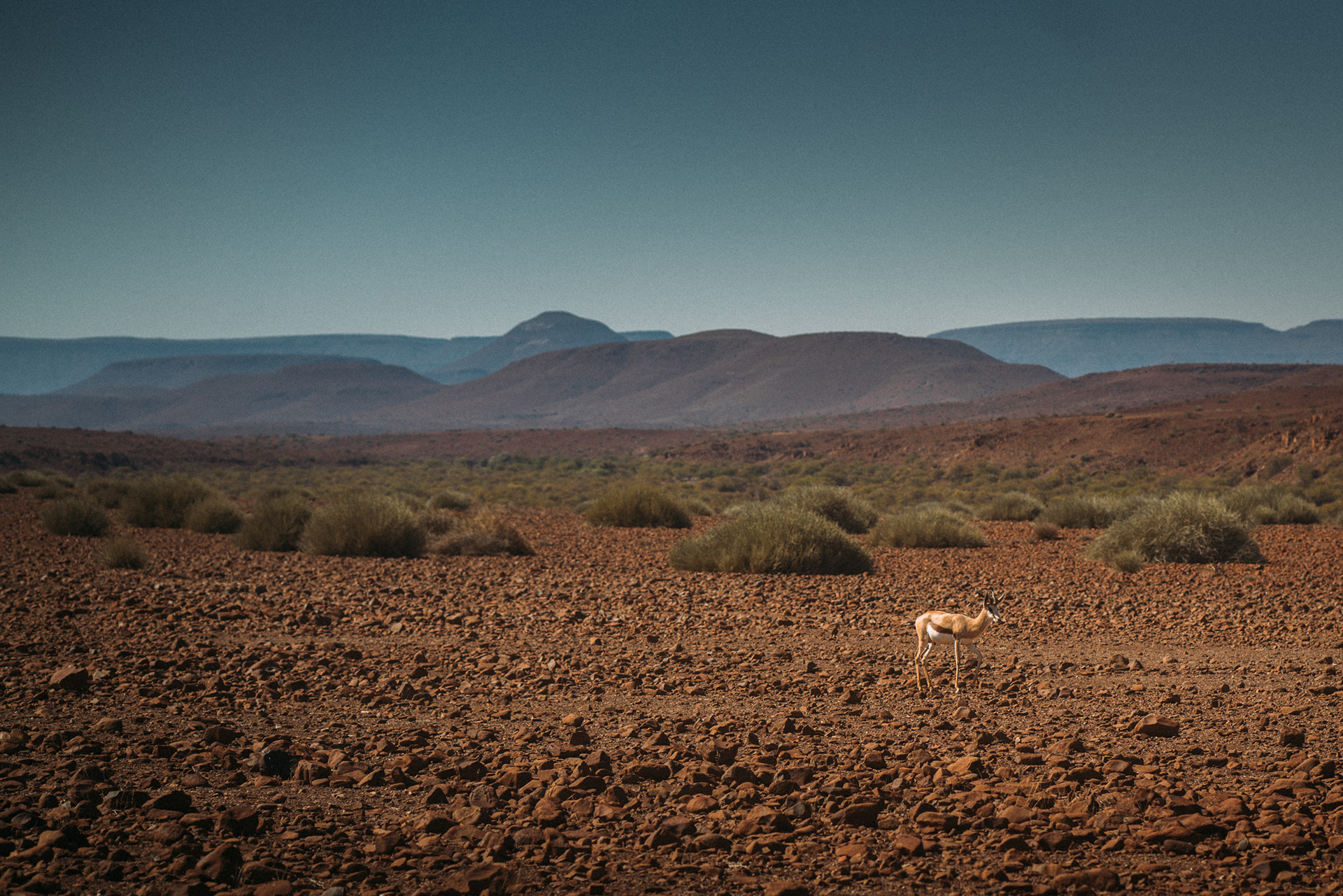
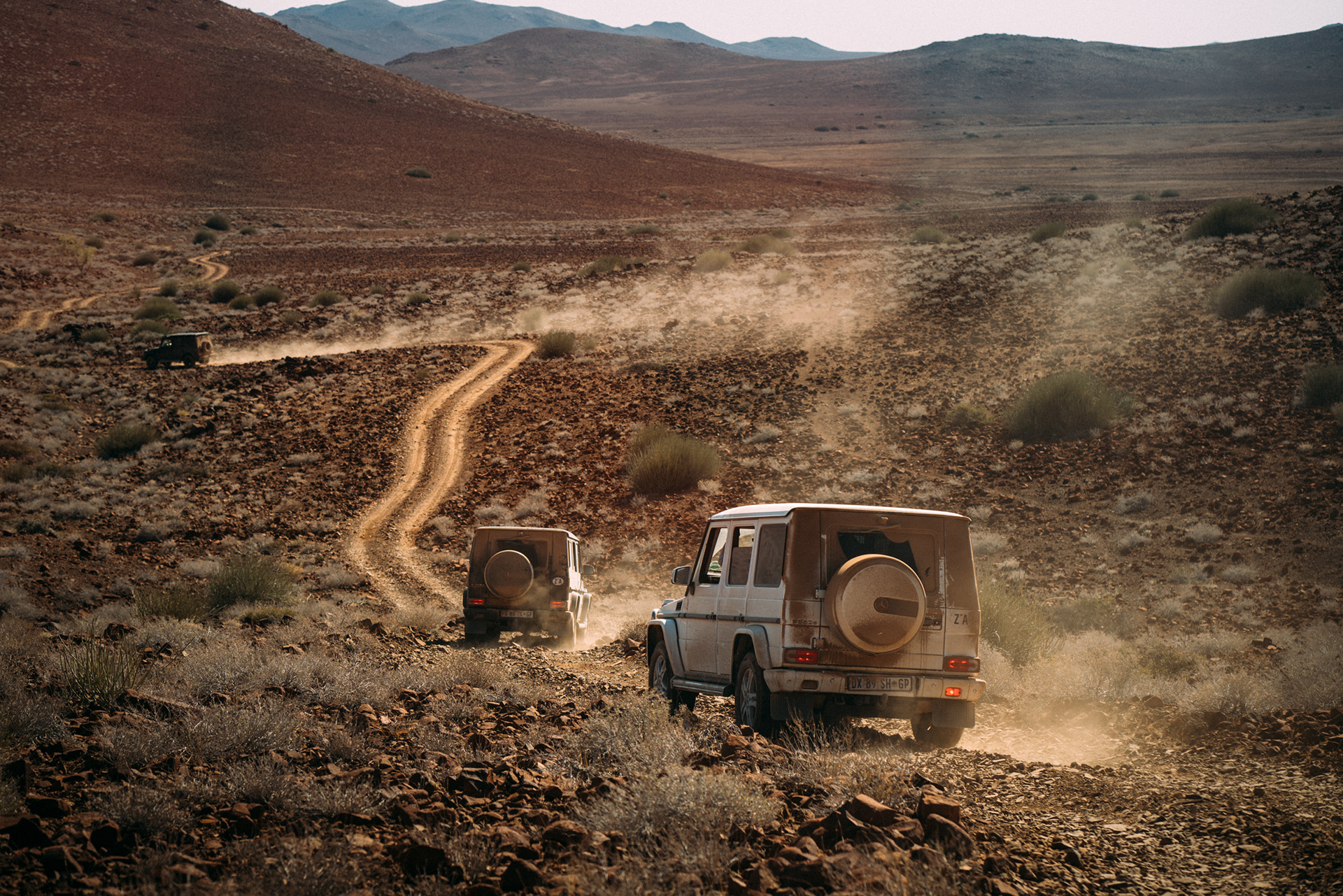

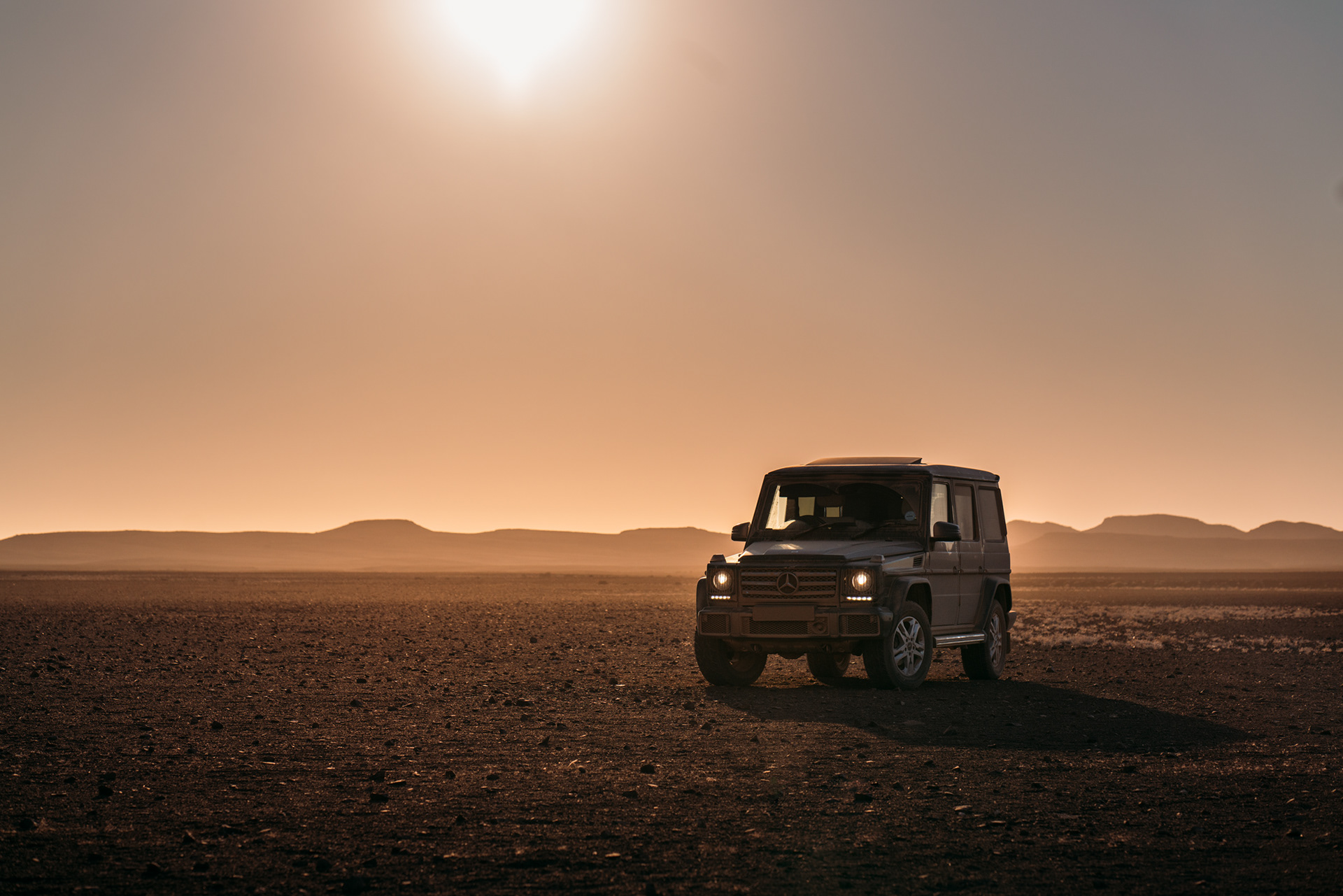

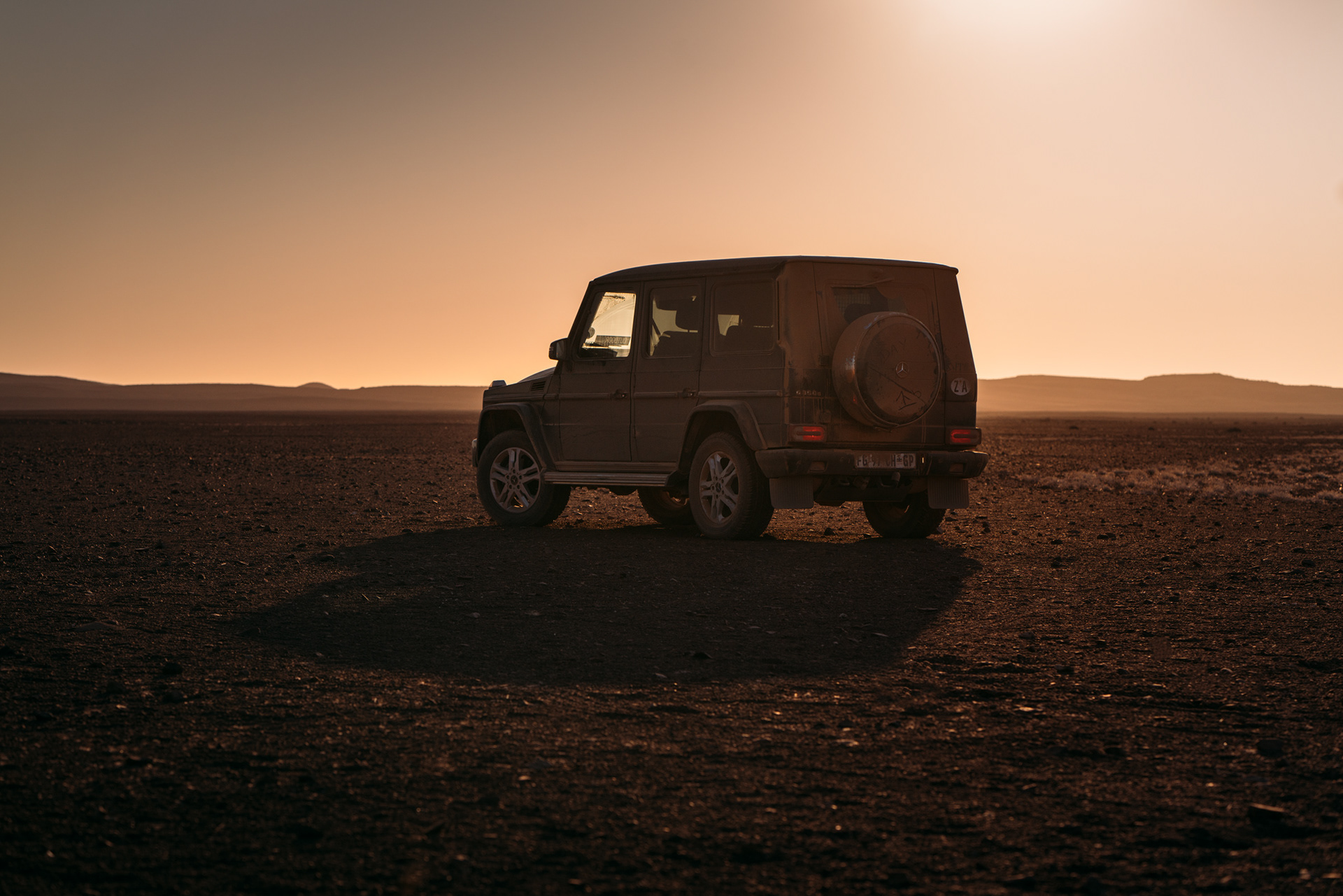
A truly wild day, pure experience from sunrise to sunset. And very subtly, between wildlife sightings and tire changes, our schedule began slipping away from us. Somewhere in the afternoon blur of jaw dropping scenery which followed, a large gap emerged between us and the car ahead. The sun pushed downward, closer to the flat martian horizon, an ever-present reminder of the hundreds of kilometers between us and camp -- and the terrifying proposition of negotiating them after dark. Floating through one of the countless high speed turns between us and the rest of the convoy, extra adrenaline seeped in as I felt the back of the car sink rapidly -- the telltale sign of a yet another blowout. Much like the first one, it looked as if someone had fired a rifle through the outside of the tire.
Timo approached from the rear vehicle, already smoking a cigarette. "How far back did that happen?"
"About twenty yards."
With little effort he produced a razor sharp, scythe shaped stone partially shod in fine Dunlop rubber and the fibrous remains of the sidewall. Our culprit.
As we finished changing the tire he picked up the rock and looked at me before casting it back into the desert. A grain of sand on the beach, one small fish in a sea of rocks specially crafted, over countless millennia, to eat tires. The sun slipped lower. Timo turned back to remind me as he walked towards his G-Class: "We have a long way to go today...fair winds, my friend." I guess that's South African for, "there's no more fucking tires."
We sped on, catching up to the rest of the convoy in time to share an unbelievable moonrise in the desert. Somehow it escaped me until later that it was the southern hemisphere's winter solstice, and with a full moon to boot.
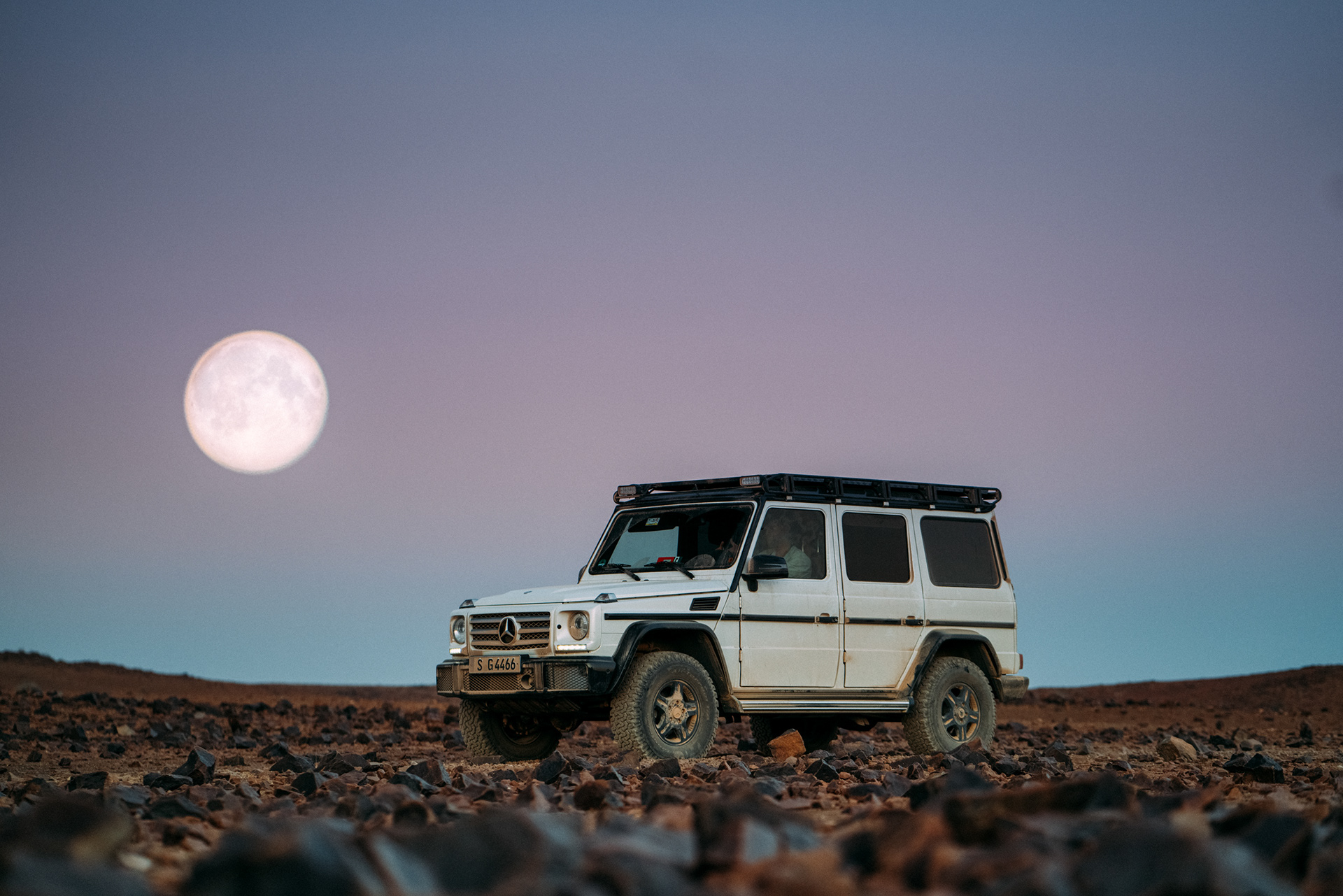

As the last of daylight faded the sobering reality of the task ahead set in; negotiating ±100 kilometers of the Hoanib riverbed on severe washboarding and intermittent G-wagen sized boulders. And then the boulders grew legs...Mike locked up the brakes as the procession of bush elephants slowly entered the riverbank. We had discussed the protocol for this days beforehand; stop and slowly back up to show respect, then on queue, file past giving a wide berth. The moment was tense, beautiful, and (thankfully) brief. We crept past as the largest of them lumbered forward protectively. Despite its posturing I made eye contact for just long enough to glimpse the peaceful and intelligent nature people often cite in describing this, earth's largest land mammal. One last photo as he gazed back at me, clearly just as curious.
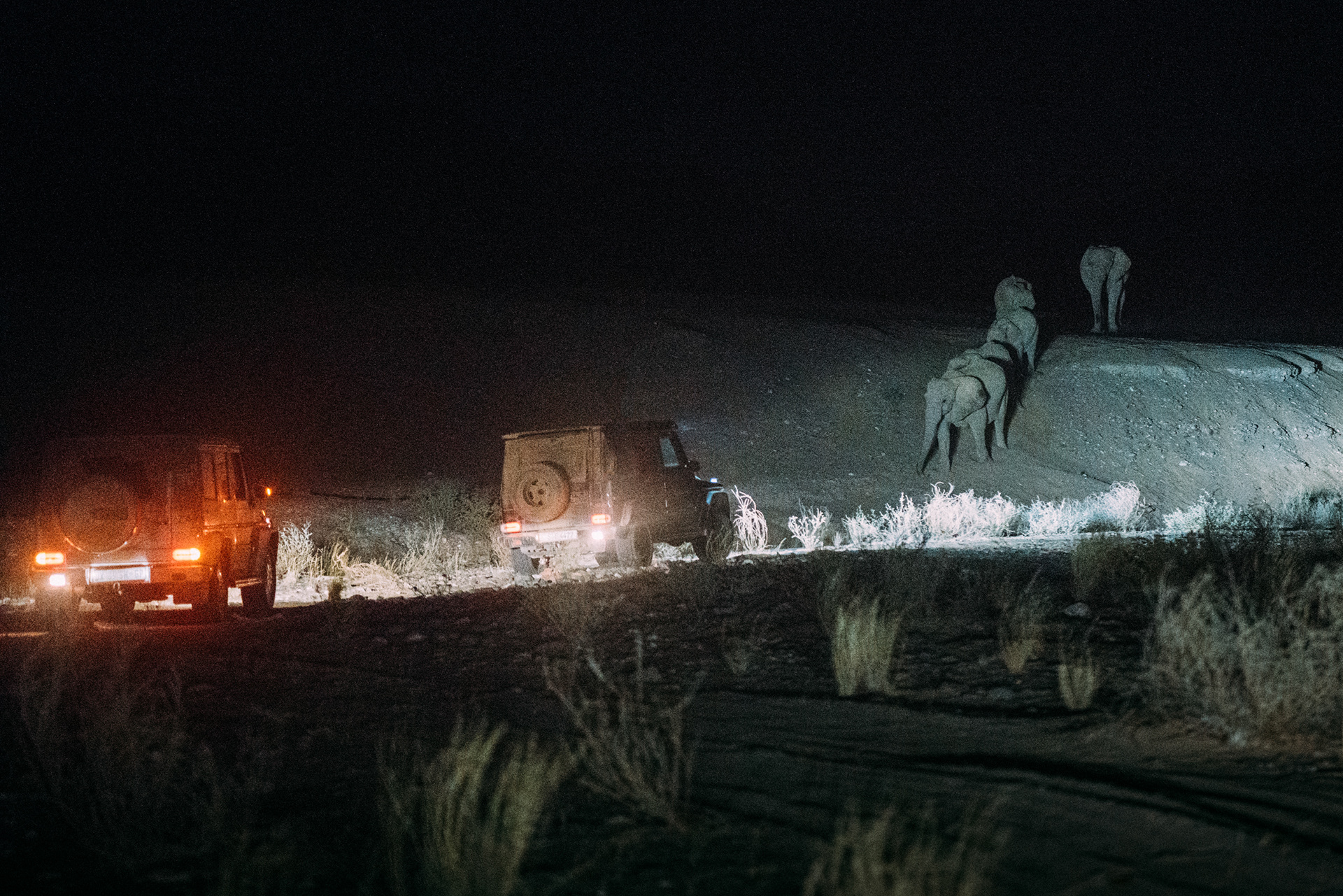
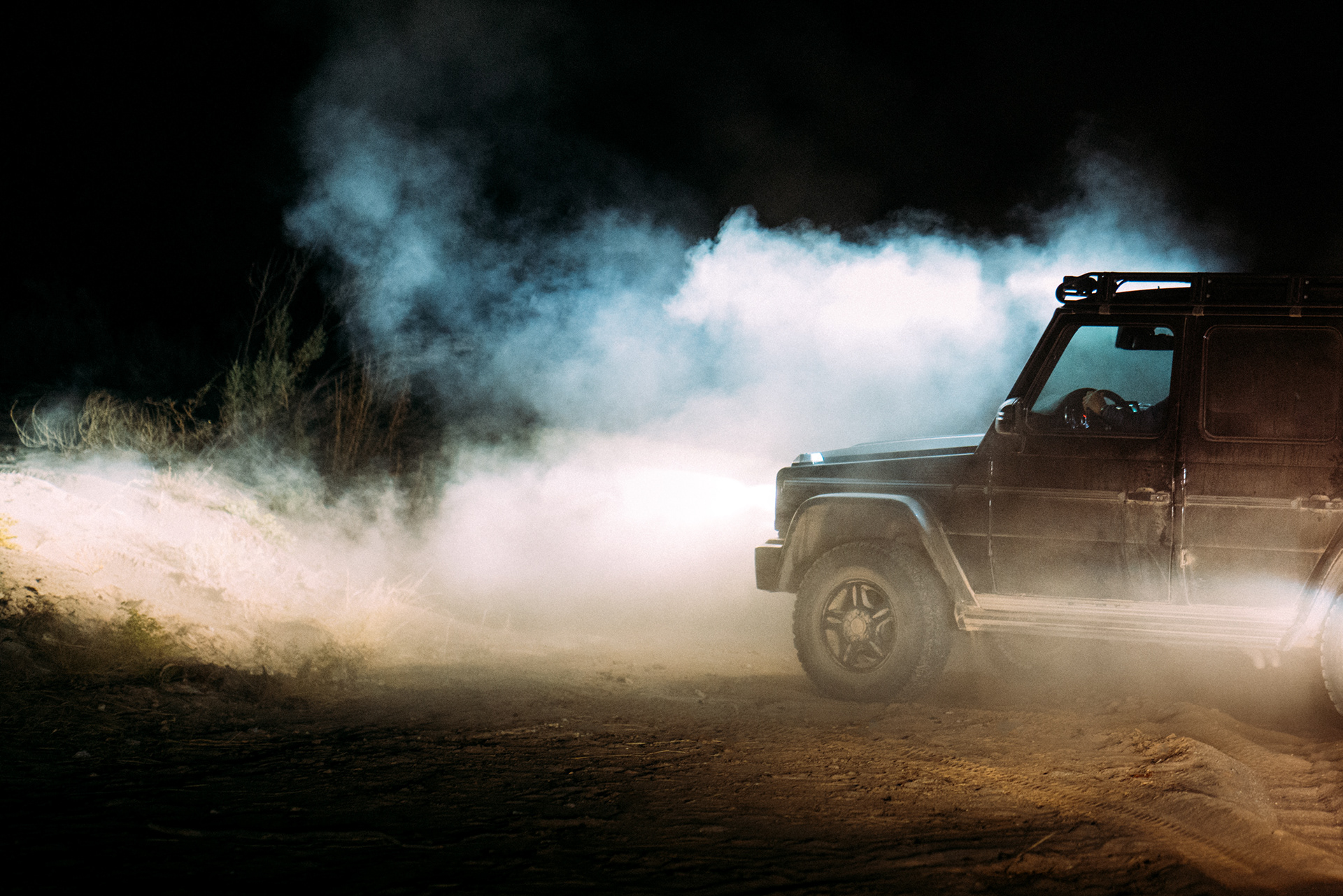
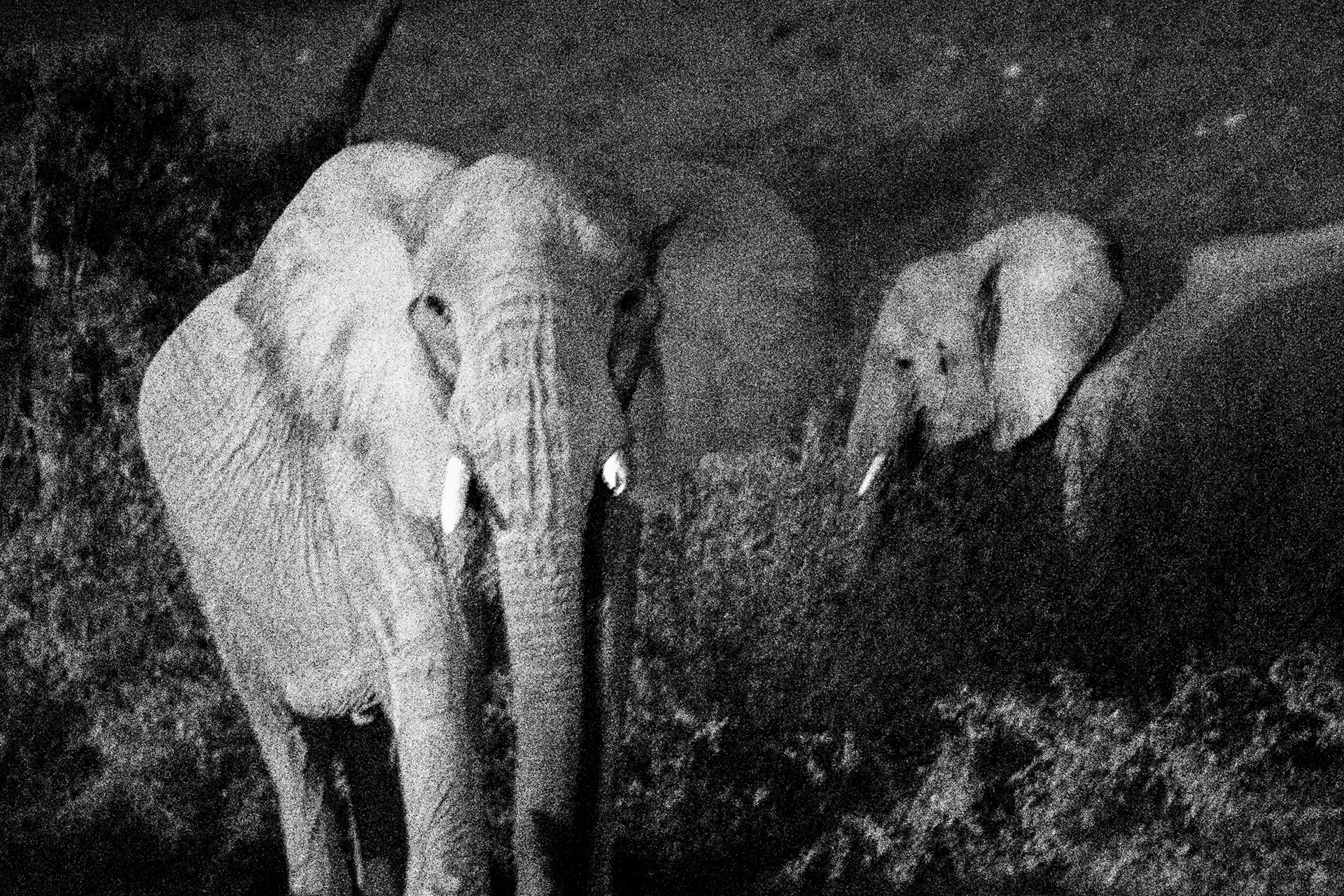
Although they look small and fuzzy in my snapshots made at ISO 32,000 let me assure you those things were HUGE, especially from inside a vehicle considerably smaller! 14 hours on the road had greatly softened any desire to spend time lingering in the presence of these beasts, which apparently weigh up to twice as much as a G350. Off we went into the last 50 km of the day, which played out as a dizzying eternity fighting a hard, single lane road in complete darkness. After many years spent traversing the network of fire roads throughout the US Park system I thought I'd seen it all...how wrong I was. This was without a doubt the worst washboarding I'd ever had the pleasure of bouncing over. Under 80km/h meant severe washboard vibration. Over 80km/h things started to smooth out, but the insanity of those speeds while hurtling into pitch black is made for men less sane than I, hopefully with helmets and full roll cages. Unfortunately the rate at which our wits left us was lower than that required to keep her afloat above the choppy sea of dirt and rocks whistling by beneath. Something had to give...
Morning brought sunlight and an inspection of the cars confirmed our fears: the merciless roads of Namibia had put a serious beating on suspension systems in several of the G350s. After assessing the situation we shuffled around, with Mike's team taking over in the damaged cars. We headed north out of camp towards the Angolan border, but within an hour we had all become ensnared in yet another sand trap.


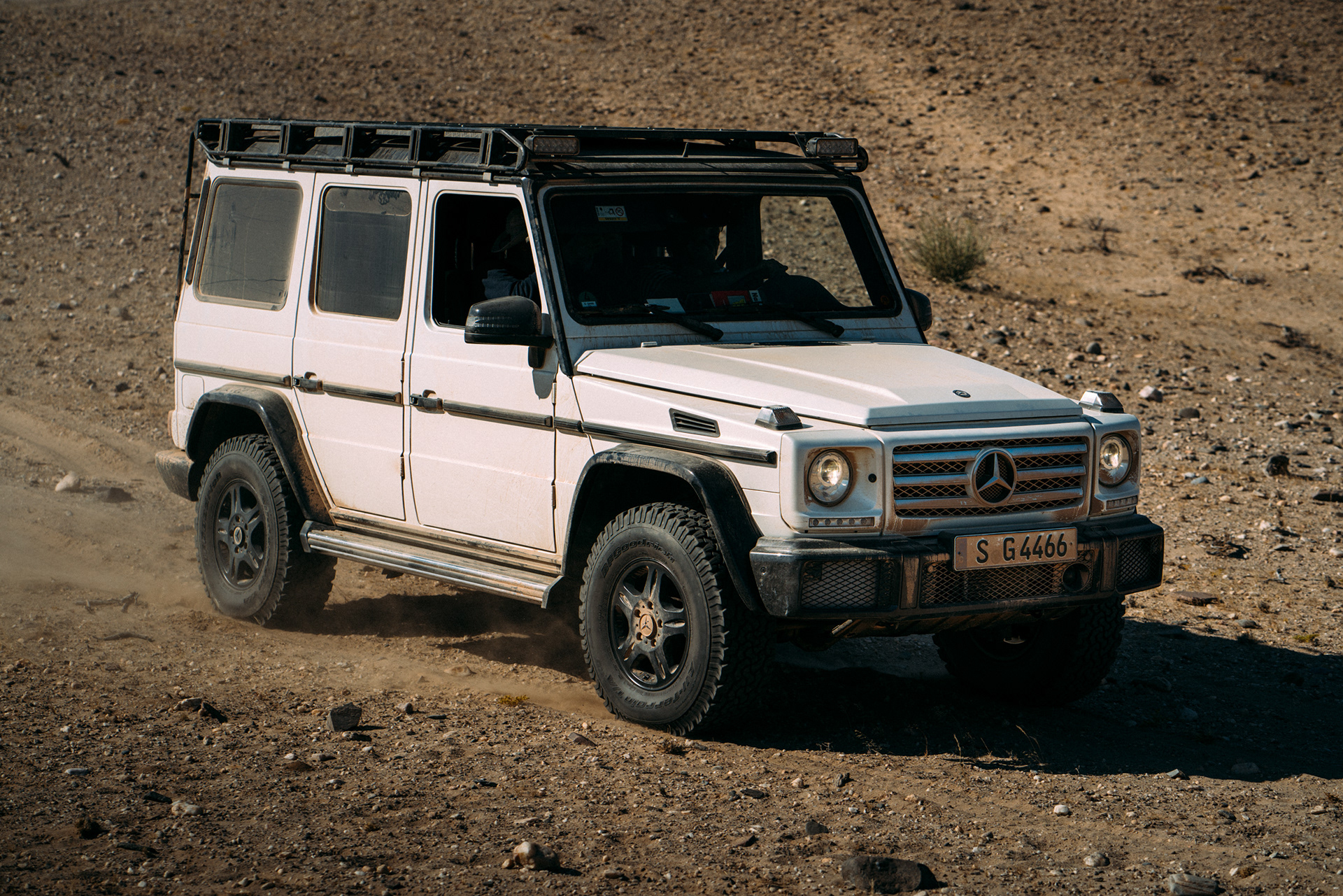
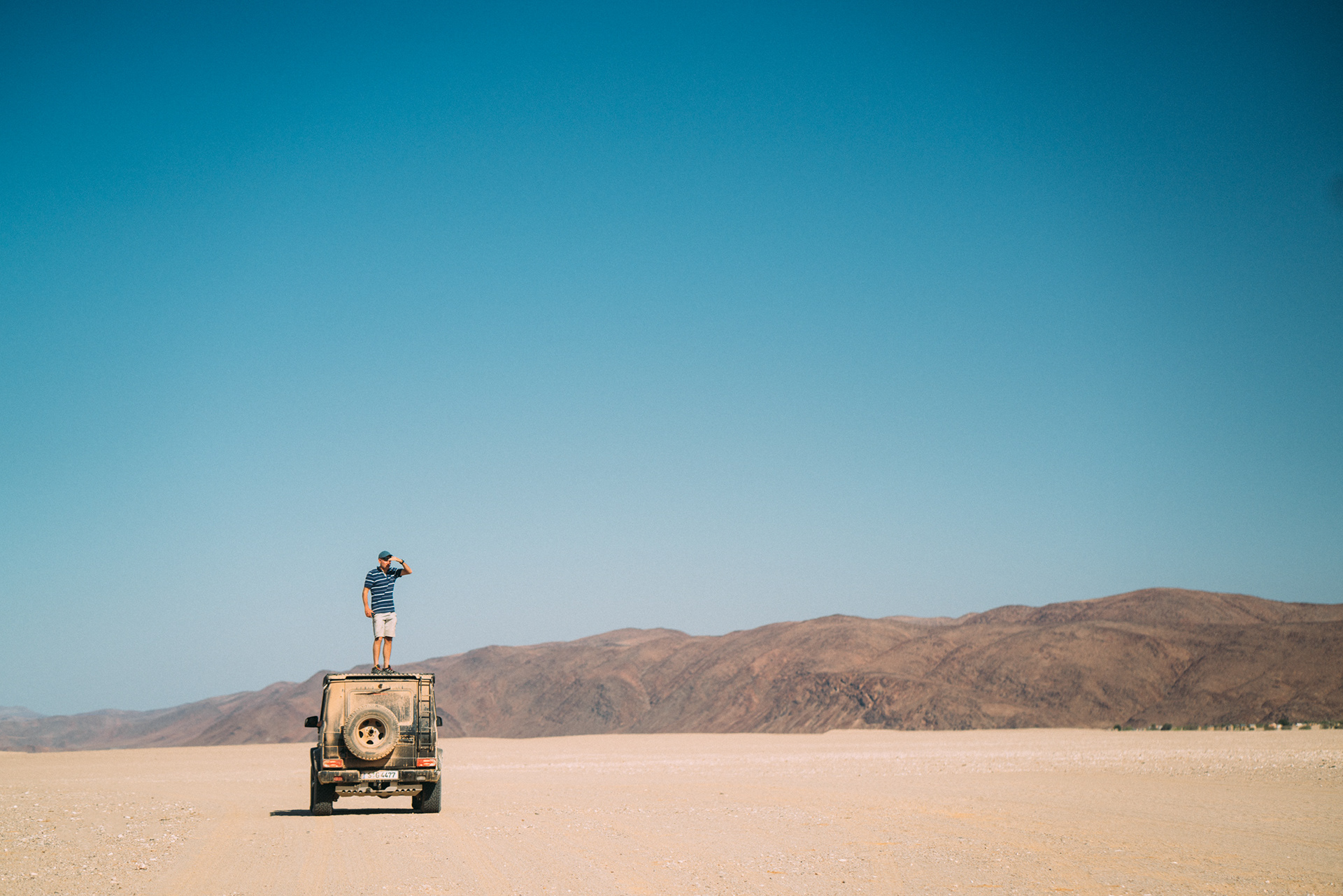
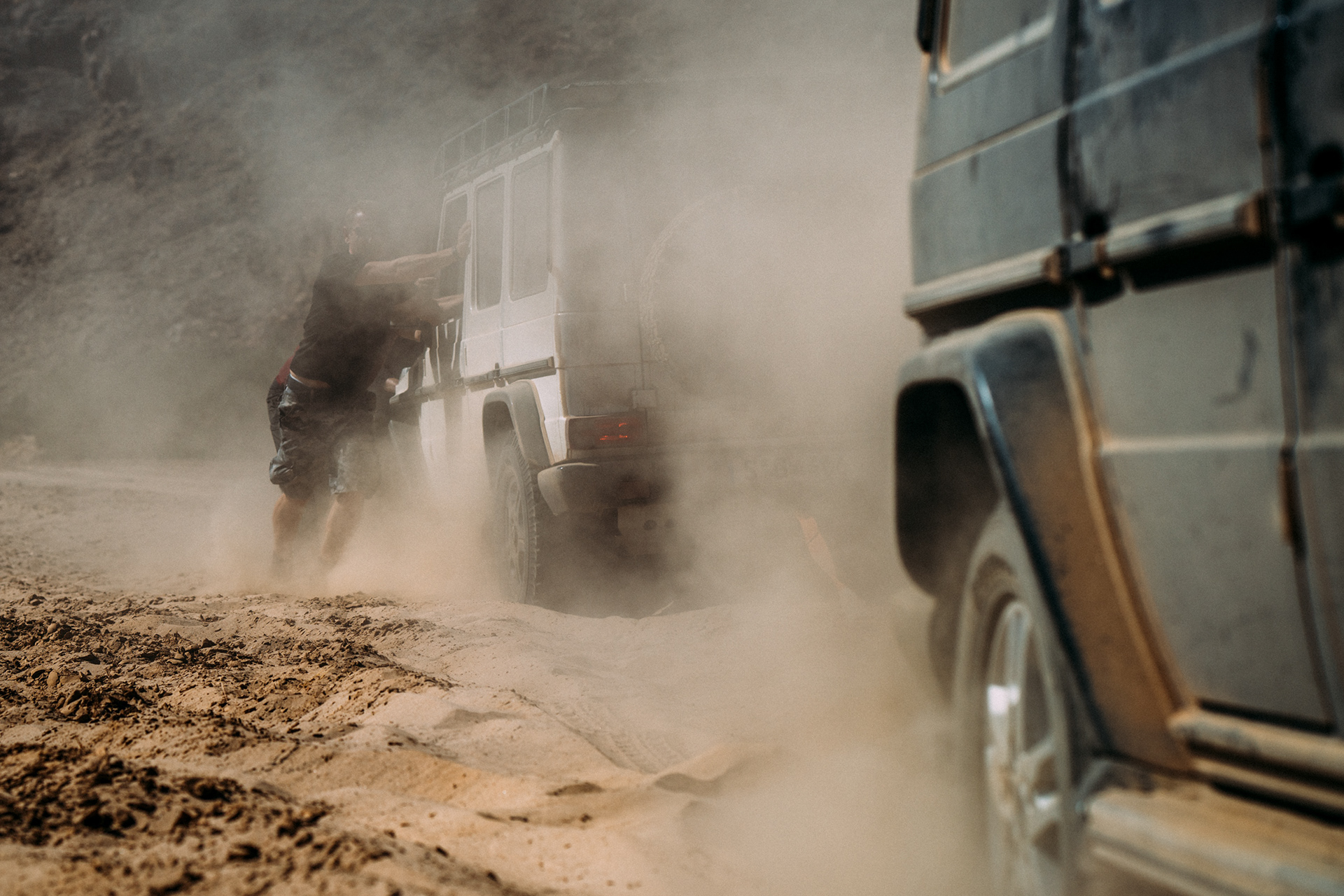
One challenge gave way to the next: a dwindling fuel supply (made smaller through our efforts to extricate ourselves from the sand) meant we had to reconcile a different approach towards our destination. There was fuel closer, albeit not by much, in the town of Sesfontein -- 120km behind us.
And so an hour out of Purros we had reached the proverbial summit of our adventure through The Namib. It wasn't what we intended, but nature was clearly telling us to turn back. On top of that, we were *far* from out of the woods. Halfway through the valley containing Purros, we lost sight of the rest of our pack for more than an hour and resorted to a lookout standing on the roof as we drove through the center of the valley trying to spot our convoy's signature dust cloud.
Stopping atop a ridge for a better look we discovered them embroiled in another flat tire episode. Timo walked a few paces and lit up a cigarette. I walked after him and bummed one.
An hour or so before sunset we still had the better part of 100 kilometers between us and the gas station -- which closed at sunset. It was for this last and most grueling leg of the day that I finally rode shotgun with Mike. The agreement was made that we would go ahead, not waiting for anyone, in an attempt to race the sun and arrive at the gas stop before it closed.

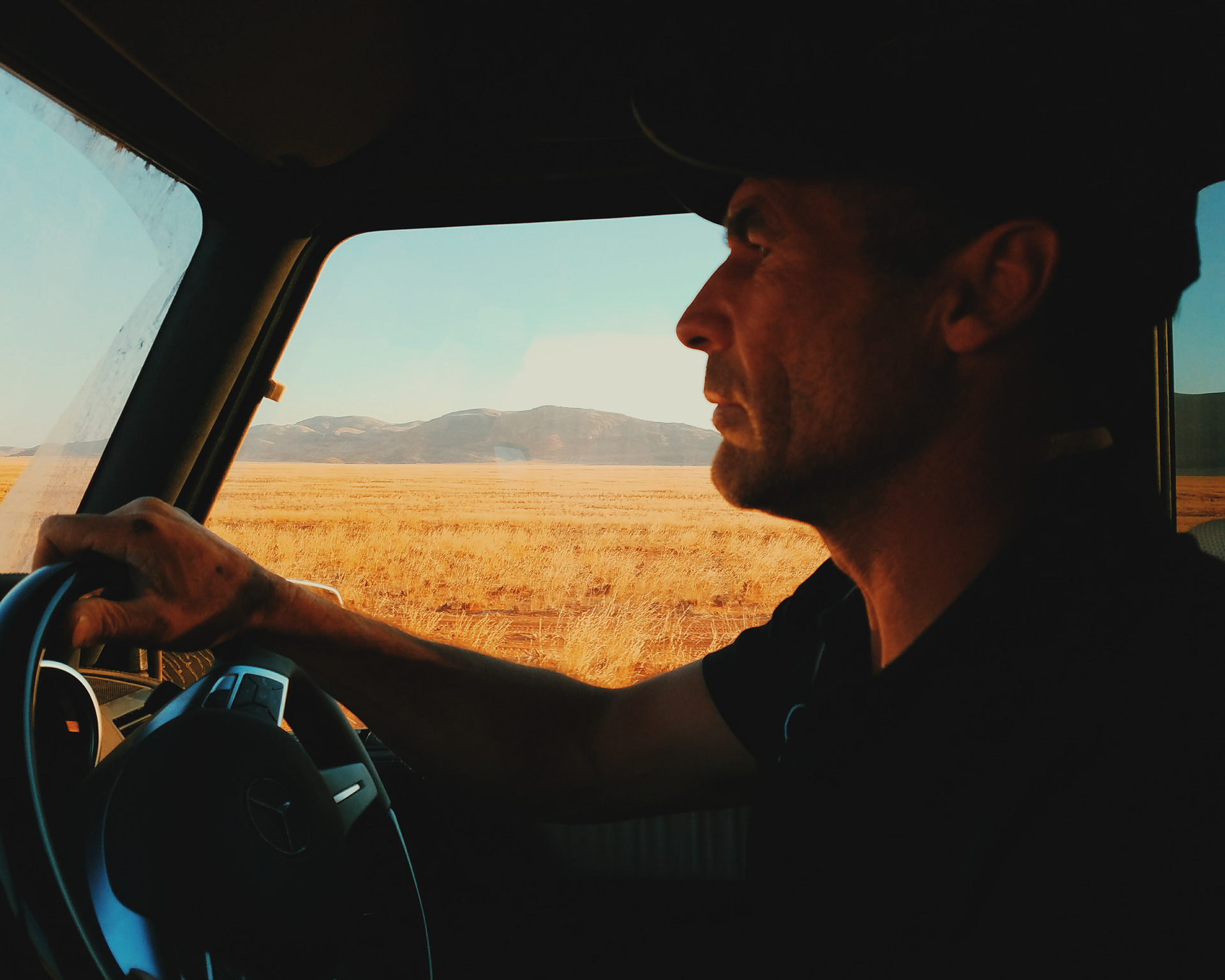

It was then I saw Mike really operating with the mentality he's famed for. The roads were tough, barely roads at all. His gaze never shifted from the sea of washboarding and jagged bedrock, making inputs with the steely calm of a fighter pilot as we bounced around inside the G350. Somewhere towards the end, as dusk faded, we ripped through a downhill lefthander with enough force to be launched into the air and subsequently receive applause from the occupants of a passing truck!
We rolled into Sesfontein at dusk and pulled up to the pump; it didn't matter though. They were fresh out of diesel.
"Son of a..."
As luck would have it we had run out of gas just a stone's throw from a late 19th century German fort which had since been converted into a safari lodge. It wasn't our original destination but it was beautiful, relaxing, and had just enough rooms to put us up for the night.
Our fuel-related anxieties temporarily melted away as Charles from GQ France took over behind the bar and poured us all cold beers. We had showers for the first time in a few days and fell asleep on full stomachs.
Morning brought the final leg (and challenge) of our adventure, which played out with remarkable precision. Mike's team had sorted diesel overnight from a nearby village -- theoretically just enough that we could all make it to our departure point, an airstrip in the regional capital of Opuwo. The small fact that we had two hours' distance to cover in roughly one hour was but a thorn compared the logistical challenges of the days prior! The roads were pretty smooth too. Our convoy pulled into Opuwo running on fumes, drove right down the air strip and pulled up next to a pair of Cessna 400s like Bond villain summercamp.

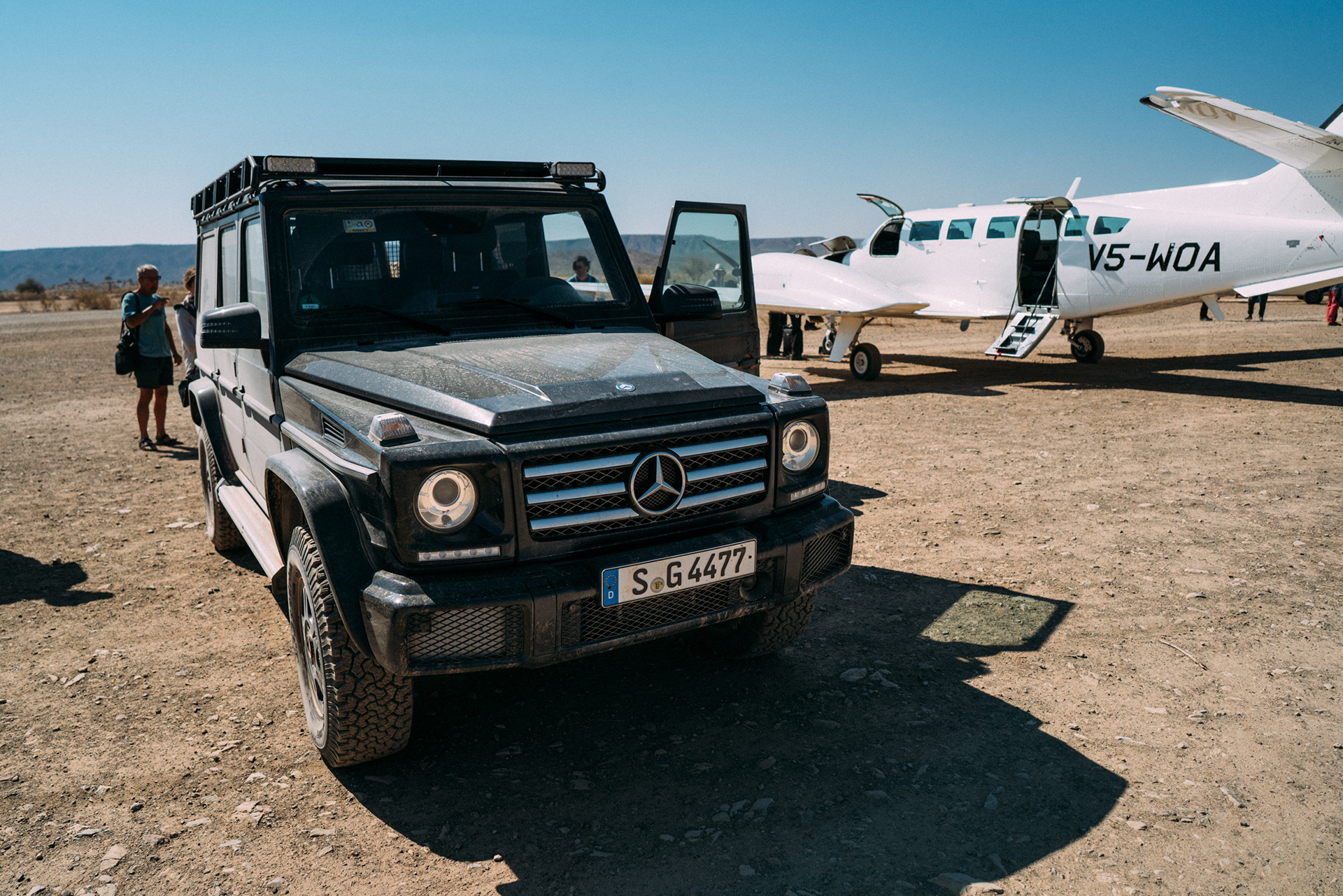
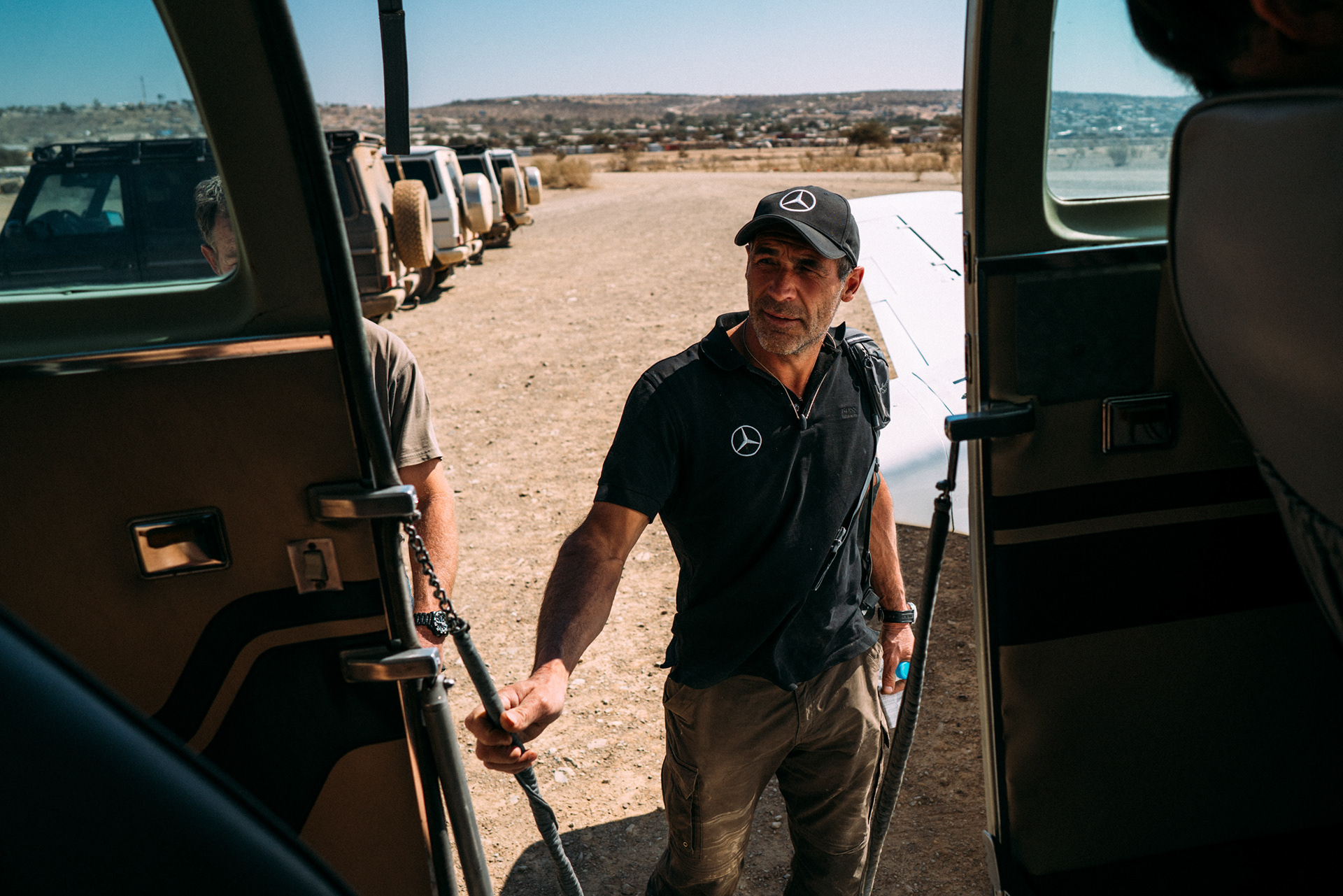

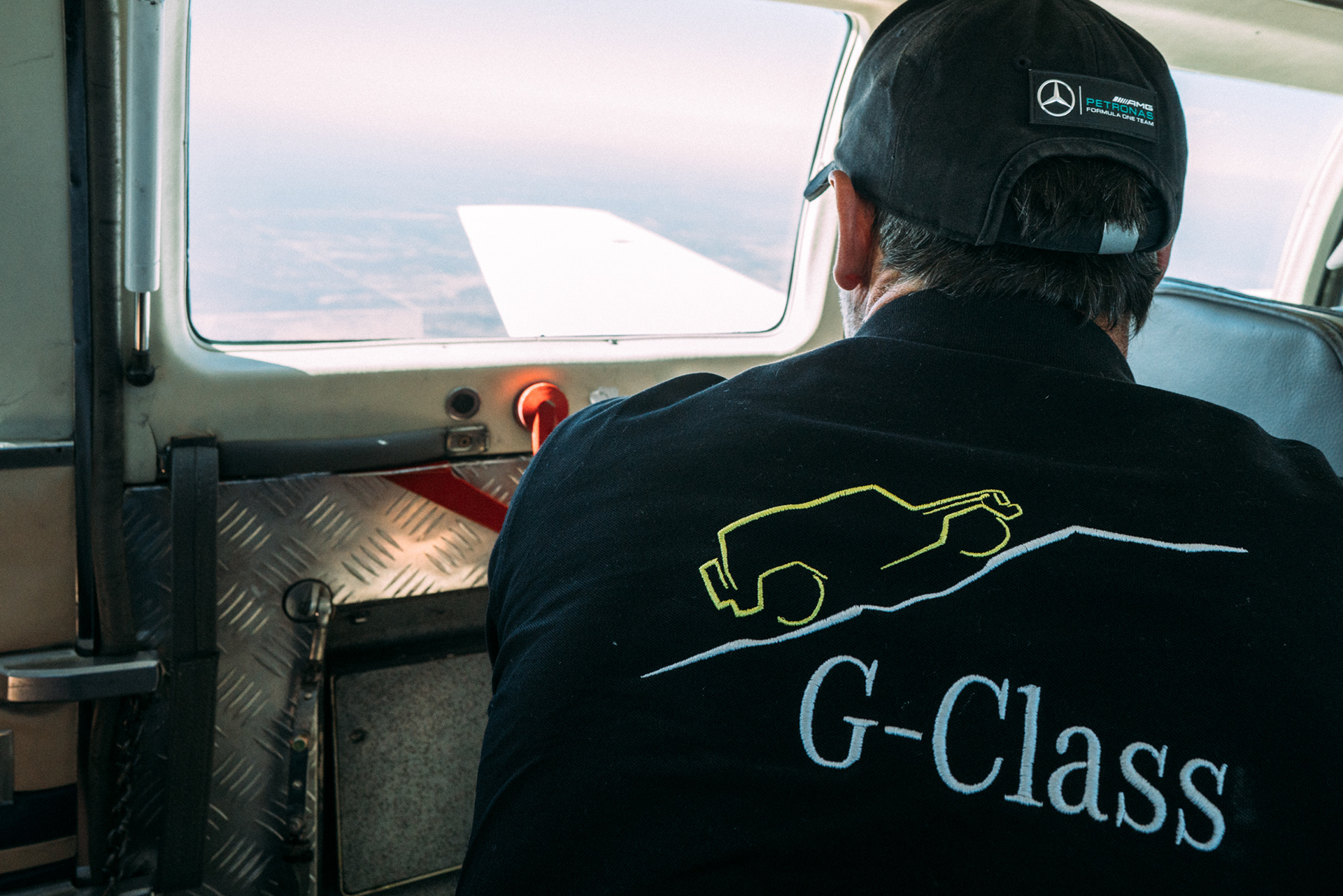
Moments later we were in the air, the drone of turboprops framing the abrupt conclusion to what was easily the craziest thing I've done this year. A glance around the plane revealed a mutual state of exhaustion; even Mike was asleep within minutes of takeoff.
Warren reflecting on Namibia.
Our days on the trail washed over and it occurred that even in our most pressing moments there had never been any real negativity or frustration. Only intensity, made positive through cooperative thinking. Our time in Namibia was full of something spectacular: the running, jumping, laughing, sand shoveling type of journalistic camaraderie so rarely seen at press events. All made possible amid persistent logistical issues by Mike's sensibilities as a captain and leader. His actions on foot and behind the wheel reveal he's a seasoned improviser, almost a magician sometimes. The invaluable lessons he chose to share were on that very subject, and how improvisation serves to support persistence towards your goals. Not just thinking big, but how to keep the faith on that path...and a reminder that real luxury means never fearing discomfort.
Then of course there was the destruction derby. Nearly a dozen tires were flattened, radiators were mangled, shocks were destroyed, and hell...there may have even been some frame damage...but that, as they say, "will buff out." The memories won't. On the road of life there are many cars. The best ones offer insight. In that regard, those G350s were already paid off -- our days with them had created experiences to last a lifetime for people all over the world, and friendships of the same variety.
Sitting aboard Pangaea on day 1, Mike promised us an adventure.
And he delivered.
